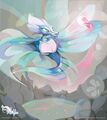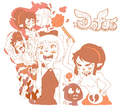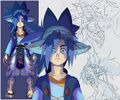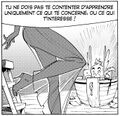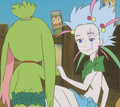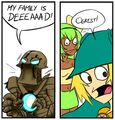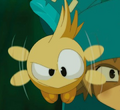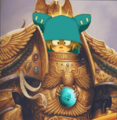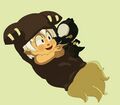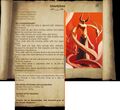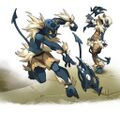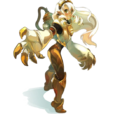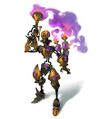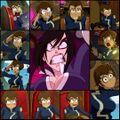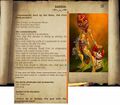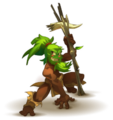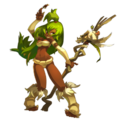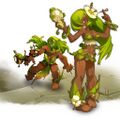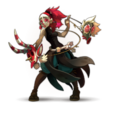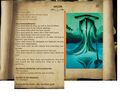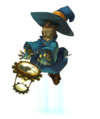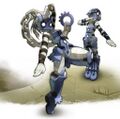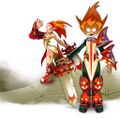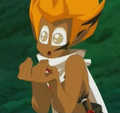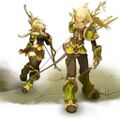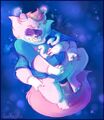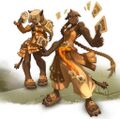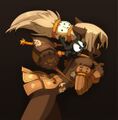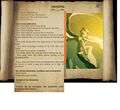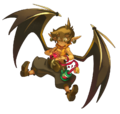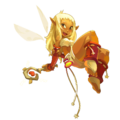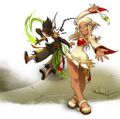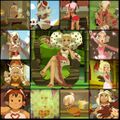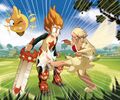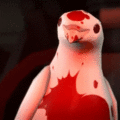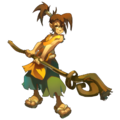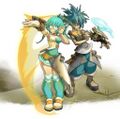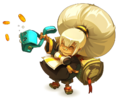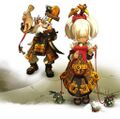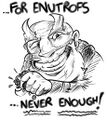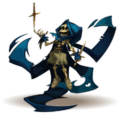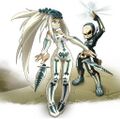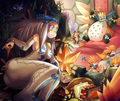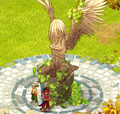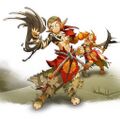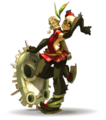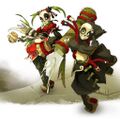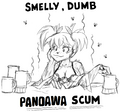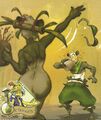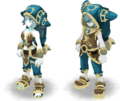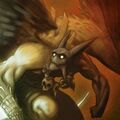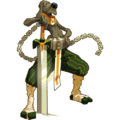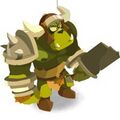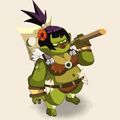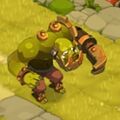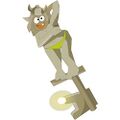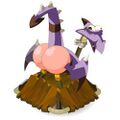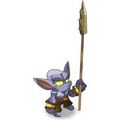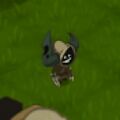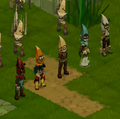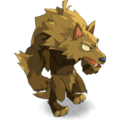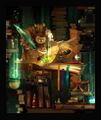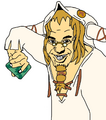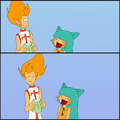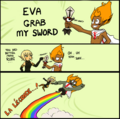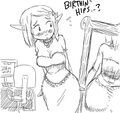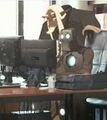Wakfu

|
This is a /co/ related article, which we allow because we find it interesting or we can't be bothered to delete it. |
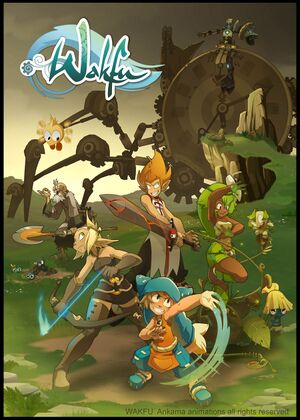

Wakfu (as well as Dofus) is an animesque French setting about a fantasy world. It was originally a mediocre MMO vidya called Dofus, then a Saturday morning cartoon with a lot of action was made to promote the game (like Transformers, but with a monthly sub fee instead of action figures). The cartoon was called Wakfu and was set over 300 years after the game. It ran for two seasons (plus one season of mini-episodes, and two movies made by other studios (one of which was Studio Ghibli)). It became fairly popular, both at home and in foreign countries like Albion and Eagleland. Then, an MMO for Wakfu was made, taking place a decade before the series. Then a cartoon for Dofus was made, being intended for a younger audience than the first show. Two more movies went into production, and between all of these came a toy line, a trading card game, a tabletop game called Krosmaster, comics, and a Kickstarter for BLU rays and dubbed episodes that /co/ went into hysteric excitement for a month over.
/tg/ likes it for a some reason. Maybe it's the Noblebright fantasy setting with a fair amount of new concepts, maybe it's the elf panda and Felinid chicks with big hips, could be that there's fanservice for wimmenfolk as well as the danglies, maybe it's just the fact that it's just a rather good cartoon. It's hard to pinpoint why, but the series definitely has some nice hips.
If you want to watch the series, both shows have been fansubbed in English, dubbed in French, Italian and Spanish, and is being officially dubbed in English, Polish, and German. Ask /co/ where to look. /co/ loves Wakfu.
The Wakfu game itself is a free-to-play/pay-to-play MMO in open beta, available both from the Ankama website and Steam. Its prequel, DOFUS, follows a similar formula; just that it's already been finished for a while (although still receiving updates).
Incidentally, if you read this and thought "Hey, that sounds cool, I remember when I used to like cartoons..." you really should go watch a bit.
Series trailer: [1] Fight scene: [2]
The setting
Something of note is how many terms for creatures and things in the World of Twelve are spelled and pronounced differently to give the setting more flavor (translation; for the Dofus game, they were trying to emphasize WE ARE NOT WARCRAFT), with minor differences from the real-world counterpart. For example, Krosmoz=cosmos. Gobball=sheep. Tofu=small bird like a canary. Bow Meow=cat with appendages allowing it to wrap around something and resemble a bow tie. Bwork=Orc. Plus terms that pop up like Osamodas, Eniripsa, Enutrof, Iop, Ecaflip, Sadida, Xelor, Cra, Feca, Sram, Sacrier, and Pandawa all mean human. Keep reading, it makes sense later.
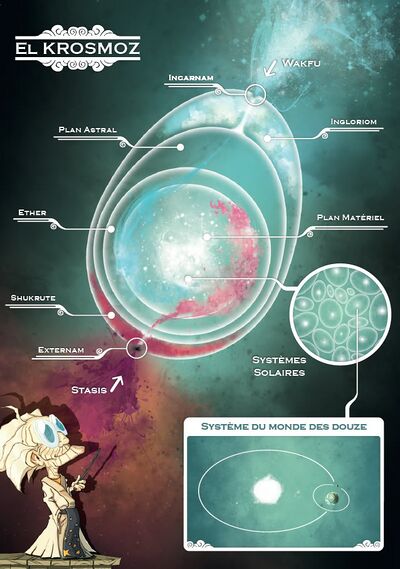
Krosmoz
In the beginning, there was nothing but raw energy. This energy comes in two forms: "Wakfu" is the force of creation, and it occurs when the energy is in a state of movement. "Stasis" is the same energy, but destructive and is stagnant. This energy, in both forms, represents all matter and magic in the setting. Unlike most settings, they are not clear "good and evil" or "order and chaos". They simply are. If something magic happens, it's a Wakfu or Stasis reaction. If science happens, it's a Wakfu/Stasis reaction somehow but it's a lot easier to understand. WAKFU/STASIS IS ALL, ALL IS STASIS/WAKFU!
Eventually, the Wakfu of the universe formed into a sentient goddess entity called "Eliatrope". The Stasis became the god "Great Dragon". The two circled each other in a "dance" (a princess and a dragon fucking, or a metaphor for a chemical reaction of the unformed energy revolving around the two entities; you decide!). Out of this "dance" came a system of stable matter and complex wakfu/stasis flow. It resembles an egg, and every single thing that exists is either within the egg or one of those two gods. The "yolk " of the egg is the material universe and all the solar systems within. The membrane is the Astral Plane called the "Ether", and in the egg white on opposite ends are the realm of spirits and gods (Inglorium), and the realm of demons and Shushus (Shukrute). The former is on Eliatrope's side near the tip of the egg, the latter near the Great Dragon's on the bottom. When a being dies, their soul travels through the bottom of the egg out the Externam and flows through papa Great Dragon, then enters the body of mama Eliatrope through which it returns to the universe in Incarnum to be reborn in a cycle of reincarnation. It's like a Get Out Of Hell Free card every time your parents have sex!
Eliatropes and Dragons
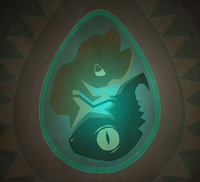
With the universe created, the two gods danced a second time and created the first sapient mortal race. The firstborn twelve of that race hatched from six eggs, called a "Dofus", directly into the world. Six Dragons, six Eliatropes, one of each born as twins from each Dofus. Rather than dying, flowing through both genesis gods, and being reincarnated into a fetus produced via sexual reproduction somewhere in the material plane like most beings are, the first twelve of the Dragons and Eliatropes return to their Dofus upon death and once both Dragon and Eliatrope sibling perish and return they gestate and re-hatch from the Dofus egg again as newborns. Dofus are powerful conduits of Wakfu, and it can be siphoned from them to make beings extremely powerful. The rest of the Eliatrope and Dragon race are born, die, and reincarnate as everyone else does. The firstborn twelve wound up as their leaders generation after generation.
The two twin races built a great civilization that predated measurable time, unlocking the secrets of Wakfu and Stasis as sciences. At some point, a race of machine beings of unknown origins called "Mechasms" descended on the Eliatrope home planet and colonized part of it, living in peace with the Eliatropes. But one of the six immortal Eliatropes, Qilby, had begun to go mad due to the fact that his gift was to never forget anything (even through death, straight back to the moment the Dofus containing him and his Dragon sister Shinonome first hatched) and he stole the heart of the youngest Mechasm, Orgonax to make an "Eliacube", a very powerful magical object (which, based on its later usage by Yugo and Adamai, Nox, and Qilby itself seems to be a multi-purpose Wakfu-powered and storing McGuffin). Without morality to guide him, Orgonax declared war on the organic races. On the order of the immortal Eliatrope kings Yugo and Adamai, the youngest generation of Eliatropes fled to a pocket dimension that existed outside time called "Emrub". With that the race boarded a massive space ship called the "Zinit" and abandoned their home world and fled through the Krosmoz.
The Zinit required massive amounts of Wakfu to power however, and each time it landed on a new planet Qilby surveyed it to have his fun and take in sights and sensations he hadn't already gotten bored of while the Eliatropes attempted to colonize. Then when he had enough and wanted change he would lure the Mechasms to this new world, which was drained of Wakfu (and life) by the Zinit to power it for their retreat. The Eliatropes and Dragons unknowingly burned a path of devastation across the stars. Exactly how many times this happened isn't clear, although during a later verbal exchange between Yugo and Qilby it was at least in the plural.
The World of Ten/Twelve
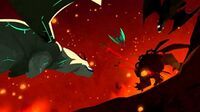

Eventually, the Eliatropes left aboard the Zinit settled on a planet with an abundance of Wakfu. For a long period of time, the Eliatropes and Dragons lived here in peace. But this time when Qilby signaled the murderous robots he was discovered by his kin. Confessing to what he had done and explaining the misery his existence had been otherwise, he told them he was unrepentant for his horrific actions and attacked them. Enraged, Phaeris severed Qilby's arm and beat him into submission (possibly with it). Left without alternative, Yugo and Adamai ordered Qilby to be sealed in an empty pocket dimension using the unique Eliacube he had made. Once again the youngest generation of Eliatropes were sealed in Emrub, and the immortal dragon Baltazar went with them as a leader and protector. There they wait for the remaining immortal Ten to signal that the world was safe again using the remaining Eliacube.
As the Mechasims invaded, they destroyed all life that they found and created an imbalance of Stasis energy which burned what remained in destructive radioactive waves. Immortal Nora and Efrim fought Orgonax to protect a flower that contained a small amount of the essence of Eliatrope herself, while Adamai and Yugo held off the entire rest of the Mechasms. As the four last heroes perished and returned to their Dofus, the goddess Eliatrope burned all traces of what had been from the planet and restored it to a blank state. The Great Dragon and Eliatrope then restored the balance of Wakfu and Stasis to that section of the universe and returned to their sides of creation. Grougaloragran, appointed by Yugo and Adamai to safeguard their Dofus, survived somehow as did Phaeris who guarded the entrance to Emrub. Grougaloragran suffered greatly from his long life, becoming both senile with memories blurring together and blind, only able to see the world in Wakfu/Stasis emanations. He continued to guard over the Dofus of his Kings, which due to having exhausted themselves to such a degree in their battle against the Mechasm leader, took three world eras to regenerate enough to hatch again. In time he also recovered his own. The Dofus of the other Immortal six (with the Dofus of Baltazar and Phaeris only having the Eliatrope occupant, and the Dofus of Shinonome lacking the Eliatrope) were buried under layers of earth and vanished from history, as did Qilby's Eliacube.

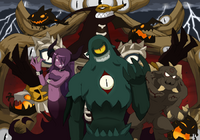
Some time later, Spirits and Demons began to leave their home planes and explore the universe. By chance, a powerful spirit named Osamodas discovered the barren planet where the Eliatropes and Dragons made their last stand. He found only a sign made of platinum which read in flaming red letters "THERE'S NOTHING HERE". Despite earlier lore saying that however, "Zaap Portals", which are two-way portals which require magical stones to activate (giving a reason why players must pay to use them) which were made by the Eliatropes still exist connecting the landmasses. It could be claimed that they were made just as an MMO mechanic and don't exist within the canon, but the first episode of the Wakfu cartoon ends in the Brotherhood activating and using one indicating that Osamodas most likely was simply not very observant.
Osamodas made a home on this planet, and his pets/companions, three great genderless dragon spirits (unrelated to the Eliatrope dragons) played and fought like hounds at his feet. This, in the abundance of such a large amount of Wakfu, stirred the energies to form simple life which their master took a great interest in. Osamodas was joined by nine of his fellow Spirits, and together they began to shape the world using their talents. Sadida and Osamodas created the flora and fauna respectively. Xelor created a giant magic clock which shaped time in ways that made it measurable and gave it value. Enutrof gave the world gold and currency, Feca gave learning, and so forth. Many Spirits began to converge on the world, all eager to be a part of this new wondrous thing. Since the Gods had depleted most of their imaginative names by naming planets and celestial bodies during their travels through the Krosmos (this is actually the canon explanation given), they merely called the planet "The World of Ten".
Humans were among the many different intelligent races who appeared, and out of them all Humans had the most potential (though not inborn affinity like Eliatropes) to shape Wakfu and Stasis. As the succeeding generations of humans were born, their bodies became similar to the Spirits they initially befriended and later worshiped, then in the afterlife waiting room of Incarnum swore allegiance to as they reincarnated. The belief and servitude of man in turn made the Spirits stronger until they became proper Gods.
Since the earliest days of the world the race of Demons sought to invade, and take the world for themselves or else make themselves a part of it.
Demons were born and at the same time as the Spirits and Gods. But while the Wakfu beings spread out into the universe and practiced their talents, the Demons (born of Stasis) fought amongst themselves within their plane. One of the firstborn called "Rushu" consumed the rest of his siblings (barring one who survived and fled to the World of Ten, more on him later), and declared himself supreme ruler of all successive generations of lesser Demons. Rushu came to the World of Ten early in its formation and demanded to be one of the number of the Gods. The Ten claimed balance must be maintained as some of their number were more composed of Stasis (like Sram) and some mostly Wakfu (like Eniripsa), and as a being of pure Stasis equaling ten beings that they could not balance him (he is not a clever Demon, simply the one in charge). In exchange for minor concessions, Rushu agreed to return to his realm and never enter the material plane again. Of course he breaks his agreement constantly after he originally found a loophole in the form of two humans willing to serve him and become Demons themselves, but has to control portals or cultists to send servants into the world. Rushu's Demons tend to become trapped by mortals in objects, which are called Shushus, making powerful (if talking and snarky) items that can usually be identified by a visible eye or moving face somewhere on it...along with the constant demands to use them to destroy something to stave off their boredom, or cutting insults and impetuous behavior coming from an otherwise inanimate object. Said objects can be anything from swords to houses to maps to cupcakes. During the early history of the world, Demons first learned to be truly evil. At their core they are only interested in destruction, for the act rather than any actual result. The worst task a Demon could end up with in those days (other than being eaten by Rushu) was building things for their fellows to destroy. Only by observing humanity from afar, and interviewing travelers (the first of whom were two Fecas, named Karibd and Silar who repurposed a Zaap Portal to lead to Shukrute) who created or found portals leading to the realm of Rushu (which became more dangerous the more the demons learned) did they understand the implications of destruction. They learned of depravity and cruelty from mankind's knees, rather than the other way around like most settings. All were shocked by the depths of evil that humans could reach. Some, like Rushu, were eager students. Others saw it as pointless diversions, others saw it as heresy to the pure act of destruction. Most of those beings didn't make it through Rushu's regime.
Eventually, two more beings joined the gods. Sacrier, a minor and weak Spirit, whispered her lessons, like "pain is weakness leaving the body" and "blood red is a pretty color!" to a lumberjack until he became her prophet, spreading her faith throughout the world and turning both the sadistic and the emo into worshipers. Pandawa was a minor spirit who discovered a simple and effective way to make bamboo wine. This made her popular enough that she earned enough worship-equivalent power to become a minor goddess, growing in followers until she was a goddess proper.
Thus the world came to be known as "The World of Twelve".
Many minor gods and spirits exist in the world, but none have gained enough followers to join the cool kids table pantheon.
Islands of Wakfu
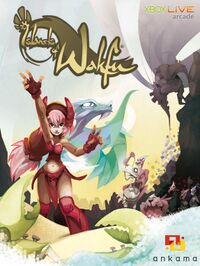
The Xbox Live Arcade vidya was released in 2011 (originally meant to be in 2009), as a sort of prequel to the animation and set 10,000 years before Dofus detailing the events of how the Eliatrope race was removed from the planet that would later be known as The World of Ten/Twelve, and how Orgonax, the psychotic Mechasm hellbent on genocide, was defeated. It focuses on Nora and her dragon brother Efrim, both from the Council of Six, as they venture through the apocalypse while kicking the asses of many to try and survive and complete their task of meeting the Goddess. Since the game was released while Season 2 was still in the making (literally three days before Qilby's introduction), people who had played or seen it would've already gotten the clue that Qilby was spouting crap about being the king and playing the goodie-good act.
It begins off with a meteor of Stasis (parallel of Wakfu; purple energy of absolute death) heading off towards the planet in a cutscenes. Nora and Efrim awake from their sleep by the voice in their heads (the Goddess's apparently) who needs the last initiate. Everyone else says otherwise, because Nora is still too young, but Mina (Phaeris' Eliatrope sister) says its urgent. If you speak to one of the unimportant NPCs, you'd find out that Qilby was suppose to be the one teaching Nora, but was no where to be found, and that Nora and Efrim have a connection with the Goddess. There are also some jealous asshats apparently, having a dragon twin does that. After following Mina into the Sanctuary that your allowed to enter for the first time, she gives them the companion Eliacube crafted from the Wakfu fountain. It's not like the Eliacube from the show, it just serves as the menu screen in the vidya that gives hints and can actually talk. It also serves as a communicator between others with Eliacubes through the network of Wik-Fi. As an initiate, they must pass the 3 veils. Mina instructs them to go to Waki-Wa for their Wakfung trial ("The Great Eliatrope Martial Art") and leaves off in a portal. While leaving for Waki-Wa, you also meet a younger Baltazar who speaks of the bond between them and Stook, who used to be an Eliacube, that tells them of Qilby's strange disappearance and how shit is going on between him and the king, who happened to be Yugo's previous existence. Upon meeting Glip (Baltazar's Eliatrope brother), both begin their training session. Efrim practices using his "Spit" on people and Nora practices on defence and spamming her portal skill as well as generally beating up them. They go over to the Goddess's statue where they are tasked to get things for her. After completing the first two (by playing a shooting game with Efrim and singing with their talking tree friend Amalami and his flowers with Nora), they get the last item from the Oracle fish that warns them if the dangers that would soon arrive, and gives Efrim the ability to summon a Platypus. After giving their offerings to the Goddess, they continue their training with Glip and discover that Stasis energy had been growing around. Eventually they enter the great hall of Chibi and see his strangely enough see his "skeleton", which the companion Eliacube notes that it's weird since Eliatropes (well, at least those of the Council of Six) were immortal. It's even more strange since you learn from the series that they all return to their dofus when they die. After leaving, the two train with Mina and learn how to grow Manolia (flowers that spawn Wakfu Gels which heal them) and complete another ritual where Efrim learns how to make the gels explode. After completing another ritual of growing a flower, Grougaloragran urgently requests to see the two through Mina. He speaks of Qilby's betrayal and that the King had been killed in conflict, most likely after ground pounding Qilby into the White Dimension. Since he had been injured in the fight, he asks Nora and Efrim to retrieve Yugo and Adamai's dofus egg from within the forest. No sooner than after Grougaloragran leaves, the whole place is bombarded by Stasis that grows deadly flower named Rozens and also kills a few Eliatropes. As they venture through the now deadly forest and kill enemies driven made from the Stasis, they accomplish Grougal's task. Another cutscene is shown that depicts the arrival of Orgonax in the forest. The two continue to fight through enemies and arrive back in the great hall only to discover that unsurprisingly, the Chibi's "skeleton" turned out to be fake, which brings the question of why they were lied to about it. By breaking into Chibi's secret path, they discover the model of Zinit as well as a message from Qilby who speaks blasphemy of the Goddess and how tired he is of being ignored. As they continue to venture back to the Sanctuary, the voice of the Goddess says that she is in pain from the statue, which was being beheaded by Lu-Fu pirates, pink dog-like enemies that steal Wakfu from the Eliatropes and kill them. After Nora beats up the troopers, she is given the power of the Goddess Song by the goddess to end her suffering. After destroying the statue, the Goddess tells them to meet her at her abode, where she would be able to speak with them again and creates a Zaap for them to leave. As they go onwards, they are forced to kill a possessed Amalami and battle through more enemies to get to the Sanctuary, which was now in ruins. After killing all Rozens, they enter through the Wakfu fountain and discover Stooks abode where all the Eliacubes were created. Balthazar requests the two to get back to the village. On the way there, they are forced to quickly flee from a stampede of large animals. After deafening more Lu-Fu, Baltazar tasks Nora and Efrim to save the children. They see the Lu-Fu admiral Odo for the first time, who immediately kills Glip with one hit. Glip's last words are to find the children within the temple before disappearing. From within the temple, the two defeat more Lu-Fu troopers and save each child from them. In the library where Qilby had blocked passage through by a secret code, you discover Chibi's testament after finishing the puzzel. It stated that Chibi left all his things to his lover Mina and made Yugo (his favorite) the king, which Qilby didn't take too kindly of. After saving all children, Baltazar leaves off to Emrub. Mina contacts Nora and Efrim and instructs them to activate the portal to the Pow-Wow. Before they could go through it though, Orgonax shows up and destroys it, leaving Nora and Efrim stranded. They quickly escape death and go towards the beach for a back up portal. A cutscene is shows Orgonax now going towards the Zinit. Farther away from the temple at the beach, the two are tasked to retrieve counch siblings before reaching the Shamipus village, where everyone had been driven mad by a large Rozen flower. Upon defeating it, both siblings are stunned by its cry and are aided by a child named Yama, whose sister Zoe will be sacrificed to the leader of a crazed sacrificing cult following the words of the Platypus, Shamipus' egg. While Nora disguises herself as Shamipus, Efrim takes the chance to break the egg (hatching a Platypus) and exposes the lies of Shamipus, saving Yama's sister. After defeating another set of Lu-Fu troopers, Yama directs the two towards the back up Zaap portal, which is activated by the souls who were sacrificed by Shamipus. On their way to the Pow-Wow they are contacted by Mina. Because of the shitty Wik-Fi connection due to the Stasis, teleporting through the Zaaps is useless, leaving them to find their own way to the Pow-Wow through a secret path. After meeting a bee named Beebee that joins them and going through more puzzles as well as fighting their way through more Lu-Fu and avoiding being slapped by trees, they manage to reach the entrance to the Pow-Wow where they find that Mina had sacrificed her life in order for them to continue onwards to the Pow-Wow to get to Chibi's island. She asks of them to plant the flower that contained her Wakfu atop Mount Zinit in the Temple of Wakanu before dispearing. Entering Mount Zinit, Beebee guides them through the darkness as they fight off more enemies, who were extracting Wakfu using a large machine on the orders of Odo. After destroying it, the Wakfu collected by the machine is released. Beebee eats the Wakfu to become a "FULL POWERZ BEE!!!", which creates a new attack for Efrim. Hearing the loud noise of destruction, the Lu-Fu General comes back to see the destroyed machine, and proceeds to try and kill the two. After beating the general into a pile of his own bones (literally), they proceed forward. Another cutscene shows Orgonax's slow ascent towards the the top of the Zinit. Traveling through Stasis filled areas and avoiding serious concussions from the rocks tiny Cracklers throw from above, they come across a puzzle that can allow them to enter a tomb belonging to Qilby. On the wall, you can see a plan depicting Orgonax with a hollow spot through his right hand, probably showing where his heart had been stolen. In Wakanu, the two must solve a series of Chibi's puzzles in order to proceed. In a secret room behind a picture of Chibi, Nora activates a projection of the Oracle fish that used to be Chibi's assistants. He activates a passage through the first room and mentions Qilby passing though earlier. After killing more Lu-Fu and solving the first puzzle, they arrive in a room where they must retrieve the Eliacube (the one seen in the series) in order to enter a sealed chamber. Upon unsealing the entrance, the arrive in the far deep end of the temple with erected statues of the Council of Six (without Nora's being there yet) where Qilby had already passed through earlier. They plant the flower before Mina's statue like she had asked. You can also see Chibi's flower planted before his own statue and a Rozen growing from Qilby's. After solving another puzzle, the two arrive at the islands, where they must first uncover Mina's love for Chibi in order for the path to his island to be opened. There, Nora meets with Grougaloragran in his human form, giving Yugo's dofus and presumably the Eliacube to him before he leaves off. Grougal later alludes to Nora doing this in the series. After that, Nora and her brother are captured on purpose by The Lu-Fu admiral to his ship, Frigate in order for them to continue towards Intiwakana, the last trial. On the ship, they finally battle and avenge Glip's death (among others). After the ship crashes, they must fight a guardian Crackler appointed by Chibi in order to move on. After that, they go through a cave and speak with the Oracle one final time, who tells that the Ali-Fu's were once like them, innocent until their world was brought to despair. They continue their way up to the Zinit, they are attacked by Orgonax. They only manage to blow up the Mechasm's finger, which allowed the Platypus to enter inside. As Nora and Efrim try to avoid being killed, the Platypus malfunctions Orgonax from within and manages to make him fall off the mountain for the time being, giving Nora and Efrim the chance to go to the top. In the final cutscene, they meet the essence of the Goddess in the form of a plant, the Goddess Beacon. As Orgonax climbs back up to murder them, Nora communes with the Goddess and achieves some sort of godly state after absorbing power. She unleashes the power, which ends up killing Orgonax as well as herself, her brother, the Platypus, and basically every living thing on the planet, making it into the barren husk it was before Osamodas arrived. It all ends there.
-
The twins.
-
Cool birdie.
-
Efrim the spitting water dragon.
-
What their in game model looks like close up. Chibi never really appeared, Qilby appeared in statues, and Yugo's dead.
-
Destroy everything to save everything. Good plan.
-
Gotta kill 'em all!
-
Sister and Brother.
-
Wanna fight?
-
Nora the cute bruiser.
-
PerryThe Platypus. -
Concept sketches of Nora.
-
The result of using the Great Goddess' power.
Dofus Era
The Dofus era technically began when the god Xelor first made time able to be measured by converting much of his plane into a giant clock, and appointing eleven heroes to guard over the months (different events occurring involving said heroes caused the different months to have different days and holidays. December only exists because Rushu scratched the clock and demanded one of his followers, a being named Djaul and described as a "black dragon", be made a protector as well). Sadida severed his soil soul and created ten dolls to seduce the three dragons of Osamodas (creating soul dolls is something the race of Sadidas also practice as a result). The three genderless dragon spirits laid the the six Primordial Dofus from which the first video game derived its name (unrelated to the Eliatrope Dofus other than having the same name, because apparently Dofus just means "dragon egg"), resulting in a race of Dragons in the World of Twelve. The six Primordial Dofus also vanished from history although for a shorter period than the Eliatrope Dofus, eventually turning up in the belly of a slain mortal dragon where they were scattered into the world and fought over by mortals looking to become more powerful by siphoning Wakfu from them (which was more or less the point of the game; collect the Dofus). Additional lesser Dofus exist as well, laid in later ages by mortal dragons along with mock artificial Dofus made from the eggs of other species.
The Dofus era comprises the general age of the first MMO game. An age of myth preceded it in which heroes rose and wars were fought, mainly between the city states and later kingdoms of Brakmar (city of villains and debauchery, established by Rushu for mortals to worship him after his first invasion) and Bonta (city of heroes and good alignments, established to oppose Brakmar). Bonta and Brakmar would eventually destroy each other, but thanks to the goddess Sacrier fucking up Xelor's clock by accident they kind of blinked out of time then reappeared with their war having ended (but Wakfu football, "Boufball", is now the battlefield). The main events from the age of myth however involve the rise of Goultard, immortal demigod son of Iop.
Dofus was an anachronistic age of heroic figures plumbing ancient ruins and fighting terrible monsters that threatened to sweep civilization away as fast as it had arisen. The technology and culture of the time was something of a 1970's/1980's version of Shadowrun, with magitek conveniences like televisions and stereo sound systems to amp up rap battles and classic metal music concerts existing alongside standard fantasy things like swords and sorcery, crusades, and plagues on tier with something Nurgle could whip up.
The era ended with the rise of Ogrest, which warped the landscape and made even the positions of the very continents unpredictable.
By the end of the era, the nations that make up the world had come to be:
- Amakna is the largest, consisting mostly of tranquil farmland (their national symbol is a Gobball (a sheep) and one of their champions looks like a massive farmer).
- Bonta as previously mentioned is the nation of good alignments, but otherwise appears as a more civilized Amakna (or Gondor).
- Brakmar is the nation of the darker side of the alignment spectrum, and appears rocky and volcanic. The first two humans to ever become Demons lie buried beneath its capital, women are actively barred from things like sports under penalty of death, and executioners are celebrities.
- Frigost is an icy, frozen nation. Although originally a tranquil place not unlike Amakna and Bonta, the (good natured) meddling of Jiva ended with a Primordial Dofus in the hands of their Xelor leader Count Frigost, resulting in a cataclysmic and permanent winter.
- Sufokia is a coastal nation of seafaring people. Founded by Foggernauts, it is the most technologically advanced nation and has non-Victorian steampunk vibes. Most of it lies on the ocean floor under a dome.
- Astrub is not a nation per say, rather a large collection of independent communities built around adventurers.
These nations go to war with each other periodically, but rarely make meaningful gains or have substantial losses. In addition, most races of the world have their own nations separate from those above. It is known the Feca, Xelor, Sadida, Cra, and Eniripsas have their own kingdoms in addition to Ecaflip City, although in Season 2 of the Wakfu cartoon a leader representing each of the races of humanity (other than Rogues and Masqueraiders) are present (along with Brakmar, but they still say that it is a council of 12). It is presumed that each class has a kingdom somewhere. There are also large swathes of unclaimed territory in the world.
-
Bonta, nation of heroes.
-
Brakmar, nation of villains.
-
Sufokia. Nation of...fishing. Also
pipesTUBES. -
The countryside of the World of Twelve.
-
Frigost, nation of ice and runny noses.
-
Amakna, nation of...everything else. Mostly farmers. The woman is a world famous chef hailing from there.
-
A map of the world from the Dofus era.
-
One of the World of Twelve maps in Wakfu. It's mentioned in the cartoon that the current state of the world makes it almost impossible to travel due to unpredictability.
-
The other Wakfu era map. It's possible Ogrest's Chaos functions like another Chaos /tg/ knows and makes the world topography unpredictable.
Goultard the Barbarian

Originally detailed in a comic book series, Goultard the Barbarian was remade as Ankama's first animated feature in the Wakfu setting. However, some parts had to be edited for television broadcast (his polygamy for example) and the animation is considered embarrassing by them today so they generally want to pretend it doesn't exist. This was reinforced by the fact that the Kickstarter English dub, which supposedly will include everything, will not have it. Despite this it's quite well done and worth checking out if taken somewhat with a grain of salt.
Goultard was born from the union of the god Iop with one of his mortal followers, named Cabotine. She bore a son, whom she named Goultard, into the world. The two were considered outcasts and were driven from the larger cities into the boonies where Goultard would grow up. One day Goultard's mother was kidnapped by a man-eating Minotaur who had killed several villagers already, and the village simply wrote her off as not worth saving as she had been considered bad luck to begin with. Despite being only a small child at the time, Goultard ventured forth and killed the beast to save her. Rather than seeing him as the hero he was, the two were exiled. This set a precedent for his life; killing shit, rescuing females, being a big damn hero. He doinked a lot of random chicks (although rather then being just a pervy wanker, he's described as "being unable to say no to any woman") before finally falling for three good witches. He married them and settled down to raise his children. However, a Sacrier hero possessed by Mongrelamus, Rushu's surviving brother, kidnapped and killed them. Goultard fell into a violent rage, killing the Sacrier but being possessed by Mongrelamus and shattering his sword (which he continued to use regardless). His skin and hair color change to blue and white and he became a rampaging brute that could put an Everchosen to shame.
Eventually, heroes from Bonta (including another month guardian) managed to calm him for his primary personality to reemerge, before it then split into further personalities (including an even worse one called "Dark Vlad"). He somehow came into possession of one of the Primordial Dofus (the Emerald Dofus, which he stole from Rushu and was a boss for players in the Dofus MMO to fight and beat for it. He spent the ages flitting in and out of legends, with the different personalities taking control and leading him on different paths. At some point he fought and defeated Rushu himself (at LEAST once at any rate), and founded an order of Iops dedicated to protecting the world using Shushus bound to swords called Shushu Knights.

By the time of the Wakfu era, Goultard's own personality (which can best be described as a MUCH more intelligent Goku) was the dominant one again. He discovered a convention of sorts made by his own fans and, displeased by how his entire life had been turned into a way to sell crappy merchandise, he proceeded to wreck the place. As he was leaving, a young Iop named Tristepin Percedal ran up to him. He laughed and told the boy that he was too late to buy any Goultard merchandise, but Tristepin said he didn't know what a Goultard was and just wanted to see a fight. He claimed that he would one day be a great warrior known as "Tristepin De Percedal The Barbarian", then asked Goultard to teach him how to fight. At some point down the road, he did just that and made the boy his apprentice. During the Wakfu cartoon series, Tristepin wandered into the desert to die after nearly killing Evangelyne while under possession from his own Shushu blade named Rubilax. Here he discovered the tomb of Goultard, who was at point point killed. His grief was cut short when Goultard chose that moment to somehow simply stop being dead (don't you wish a certain someone was capable of that) claiming that he had just settled down for a power-nap and his companions had assumed he was dead. He arose from his crypt, gave Tristepin a pep talk and helped him reestablish dominance over Rubilax, then wandered off again. In the second season, Rushu manages to open a large portal and the realm of Demons invades the world. While the Brotherhood of Tofu (sans Adamai and Yugo who were off fighting their own battle) and the Foggernaut kingdom of Sufokia held off Rushu's forces, Rushu set forth to finally claim what he felt was his. Almost as soon as he was through the portal however, Goultard appeared and called him stupid (Rushu is sensitive about his intelligence, to the point that a dumb joke (that he gets) is equivalent to calling Marty McFly a chicken). Rushu fought Goultard, and was easily defeated. Goultard revealed that he was the new incarnation of Iop (for the record, a god passing down the title has never happened before), and watched as Rushu consumed his entire army (which consisted of all Demons and Shushus in his domain) to become powerful enough to rival Goultard. Goultard tackled him back through the portal he'd come from, which closed behind them. During the fight itself, he made a comment to Tristepin (who wanted to come with him) along the lines of "Stay here, daddy." Not long after he found out Evangelyne was pregnant (among other things). Goultard appeared again in the OVAs, having beat most of Shukrute into submission and re-entering the world again to be there for his apprentice.
-
Young Goultard and Cabotine. Yes, he intends to eat that. Yes, he probably killed what it was attached to.
-
Adult Goultard doing what he does best.
-
Babes love redheads covered in blood.
-
Goultard doing the OTHER thing he does best.
-
Goultard marrying one of his three wives with monsters he's beaten in attendance.
-
Goultard's family is taken.
-
Goultard's family is slain.
-
Why you don't piss Goultard off.
-
Posessed Goultard.
-
Dark Vlad Goultard.
-
Goultard meets his future protoge.
-
Sums it up pretty well.
-
Goultard as he can probably be found post-season 1.
-
The origin of Rubi.
Dofus: The Treasures of Kerubim
The cartoon featuring the Dofus era came after the Wakfu cartoon, but predates it by an entire era in-story. It revolves around an elderly Ecaflip gentleman named Kerubim telling stories of his youth (and romantic exploits, which mainly involve his attempts to win the love of his life; an Ouginak named Lou) to his adopted son Joris (who in a heart-melting way calls Kerub "Papycha") and his live-in Osamodas maid Simone who's arrival to the town begins the series and who's leaving the town ends it. Kerub has long since retired from being an adventurer, and instead set up shop inside a Shushu house selling his own souvenirs to adventurers. A subplot involves Simone's lesbian relationship with an Ecaflip named Julie (meaning it'll never see daylight in the US as anything other than an Adult Swim show unless they become French-kissing cousins, pun intended) which was tastefully handled. In Kerub's shop many things are seen in the background, including a Primordial Dofus and Rubilax. This cartoon was generally self-contained stories, and had very little relevance to any ongoing plot other than world-building. An upcoming movie continues the story, and possibly explains how Joris seems to be an immortal being by the time of the Wakfu era.
Although it isn't touched upon in the cartoon, the Dofus vidya had Kerub as an NPC who would provide silly flavor text when shown different items. A quest revealed that he is in fact a literal son of Ecaflip, making him a demigod similar to Goultard. Unlike Goultard however, Kerub becomes an old man physically.
-
Luis (the Shushu house), Kerub, Simone, and Joris. Watching TV in a fantasy world.
-
Julie and Simone.
-
Lou.
-
What most Wakfu fans got out of Treasures of Kerubim.
-
They're so adorable together.
-
The OTHER thing most Wakfu fans got out of the show. Chiki wa.
-
Father/son bonding.
-
The old cat's still got it!
-
I'm stealing that line.
-
Pissing off the young Kerub was unwise...
-
...unless you were big enough to ride a Tarrasque.
The Guardians
A vidya where you played as an Eliatrope in Emrub was made by Ankama, which detailed the backstory of the Eliatropes. It preceded the Wakfu cartoon, and thus many of the big reveals (Qilby is evil, Yugo was a king, and so forth) were not a surprise to anyone who had played the game. Long story short; Baltazar has been lying to the Eliatrope children and telling them nothing exists outside Emrub. You can find lore on all of the Immortal Eliatropes, lore on the Mechasms and the Zinit, and so forth.
In the story, the Eliatropes built a new culture inside Emrub. One day an Eliatrope Mary Sue villain discovered the rest of the universe but it frazzled his brain and he grew up, blah blah blah, you kill him and get ready to leave to the World of Twelve. The real interesting part isn't the game plot, but rather the meatspace side. Ankama had a designer who came up with the villain, a 2deepforu and tormented 2-dimensional character that served as the game's driving force. He then left Ankama, under dubious circumstances. He then threatened to sue Ankama for the rights to the character. Ankama changed the character a bit as much as they could without changing the game and changed his name from some bullshit spelling of "Nail" to "N". Wasn't enough. So he sued Ankama, and lost the suit. Which lead him to break into Ankama's offices and waiting for execs to arrive before threatening them.
To get the fucker to bugger off, the character in the game was changed to a simple goblinish being which fucked the plot royally, but since Ankama was working on Wakfu season 1 by that point they gave less than a shit anymore. While the canon events remain (somewhat), the second season of Wakfu changed quite a few things. Like the Goultard movie it is canon, but not FULLY canon and can be seen as an interpretation of events only. N obviously never existed.
See: Malal.
-
The Sue himself.
Ogrests Chaos
The primary cataclysmic event of the setting. Detailed both in a comic series, in in-game lore, and finally in an animated movie made by none other than the late Studio Ghibli studio. However, the production of this series is considered "troubled" at best due to issues between the legendary anime studio and Ankama's strict requirements. Still, its a great watch and can be purchased legally on Steam, of all places.
One day, an alchemist named Otomai (who was the demigod son of Feca) was experimenting with rare crystals made of solidified Wakfu called Ogrines and mixed them with candy he/his created servants spilled by mistake. This created a living being, whom he named Ogrest.

-
The supreme villain of the setting, Ogrest, wrestling with his maker Otomai.
-
Ogrest's revenge.
-
Ogrest atones and is purified.
-
Ogrest, temporarily subdued.
-
Ogrest meets the seductress Dathura. The fate of the World of Twelve is sealed.
-
The Ghibli version. In this one, he fell in love with her at first sight while she was lifeless.
Ogrest, thanks to his magically charged body, had peculiar properties to him like being nearly indestructible and having tears which grew as they fell (this was discovered when after being frightened as an infant he flooded his father's shop). His father cared for him and gave him a happy and sheltered childhood. And he would have had a pleasant life of it, in spite of the Chaos in all his works had his path not been crossed by a creature who causes more perplexity to man than the race of Boowolfs, Ouginaks, and Shushus put together; and that creature was a woman.
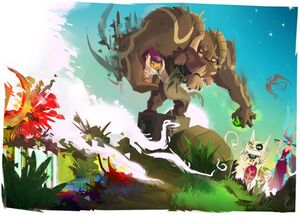
Dathura, one of the god Sadida's dolls, wanted to be a real girl. Recognizing Ogrest as a being of immense potential ("Stick with me kid, we're gonna go places"), she convinced him when he became an adult to collect the six Primordial Dofus to use to turn her Human. He swallowed each one as he found them, growing in size and strength but losing his intelligence rapidly as he did so.
Once the Primordial Dofus were gathered the gods became fearful: Ogrest's might was near on par with their own and he was unpredictable (and depending on your source of the story committed some very evil acts getting the Dofus). The Twelve declared war on him, and in the ensuing battles he cast them off their home on the tallest mountain in the World of Twelve, Mount Zinit (which at one point was the spaceship that carried the Eliatropes and Dragons to the World of Twelve). From here, there's multiple stories of what happened. In one, while exploring the entrances to the domains of the gods Dathura fell into the Deep Abyss of Time, the location of Xelorium, the realm of Xelor. Rather than try to find her, the great manchild began to weep and wail as he's dumb as a box of Iops. In another, Ogrest's relationship with Dathura was one-sided and he gathered the Dofus to attract her. After realizing she cared about the Dofus and not himself, he himself threw her into the Deep Abyss of Time and went into a hissy fit that lasted centuries. One story details that Dathura used the Dofus to become human, but their power slowly stopped working on her and she faded from existence causing Ogrest to fall into grief, not realizing that his anguished wailing was causing the world to fracture. Another story involves the Twelve causing Dathura to fall into the Abyss. In this version, Ogrest beat the Twelve and they fled from Mount Zinit. The final account has Dathura as an evil manipulator who tricked Ogrest into gathering the Dofus. Realizing what he had done, he himself threw her into the Abyss to stop her and his current state is a tortured one rather than a malicious one.
His tears, wailing, and fist pounding caused a cataclysm of near world-ending proportions. Tidal waves, earthquakes, and volcanic eruptions wiped out most of the life on the planet, and turned the Pangaea-like continent into a series of large and small islands. Only the direct intervention of the Gods saved mankind, and the continued effort saps them of their former strength. With the ensuing devastation, more people than ever before clung to the worship of the Gods reducing the number of normal-looking Humans in the world and granting the gods new strengths in return. Ogrests Chaos continues to warp the creations of the Gods, making animals into monsters which harass mankind. Geography is a temporary state, and thus only magical maps are of any use in the long run. The technologies developed in the Dofus era were largely lost (not entirely however, as what remained simply became more valuable and likely to be found only within civilization) and the world gained a patchwork and cracked look not entirely dissimilar to a fantasy version of Star Wars. It's an inherited world, not a created one.
As civilization was rebuilt, the former twelve kingdoms were replace by small kingdoms and a large number of chaotic and transitory political systems which can rise and fall in a month. Most of these frontier city-states are founded and ruled by those who "have proven their worth to the gods and people" AKA adventurers. While the major nations (Frigost, Amakna, Bonta, Brakmar, and Sufokia) still remain their grasp on the outlying towns and provinces is almost non-existent.
New organizations spanning the world arose, which behave similar to the faiths of the Twelve but are more like adventurer guilds or cults dedicated to myths and past figures. Among them are a cult dedicated to Ogrest that make up the quota of Chaotic Evil cultists for the world, a cult to Otomai of fedora tippers who believe only in SCIENCE, a cult to Dathura which believed in finding her and returning her to Ogrest will save the world, and so forth.
Noximillien the Clockmaker
Detailed in an animated movie in a different style from the main series, this premiered alongside the finale of Wakfu and explained the origin of the primary antagonist.
During the end of the Dofus era, there lived a poor man and his family. Noximillien Coxen, the father, was a Xelor who made clocks and mechanical devices in lieu of an inability to use the Xelors' usual time magic. Despite his genius, he was in perpetual debt to his irritable Enutrof landlord, and worried deeply that he was unable to provide for his family properly. One day, as Millien unveiled to them his newest creation, a flying clock which could follow its owner, his dog Igole chased the still-imperfect device down the beach to a cave hidden in the rocks, with the clockmaker in pursuit. Deep in a tidal pool, Millien and Igole discovered a strange glowing blue cube. Recognizing it to be something of extreme importance, he took it home and began to study it. He became more and more obsessed, gaining knowledge from the strange thing that he claimed identified itself as the "Eliacube" (in fact the very same as Qilby's made before time was even measured) and churned out new inventions rapidly. He became fixated on the potential worth of these discoveries and how they could help his monetary troubles. He began to neglect food and sleep in favor of his work, and lashed out at his wife when she pleaded with him to get rid of the cube, and end his isolation from his family. Determined to snap him out of his obsession, she took the children and went to stay with her sister, leaving a note explaining herself to him and asking him to find her there. But he the promises of the cube's creations were too tempting to Millien, and he simply returned to his shop.
Months later, his landlord paid a visit to the house. A gaunt and haggard Millien emerged seemingly out of thin air and tossed a large bag of gold at the Enutrof's feet. He told the man to leave him to his work, but the landlord reported his debt had already been paid off by his wife for quite some time. Instead, he had come to see how Millien was doing with the loss of his family: during Ogrest's Chaos, the entire landmass where his family had lived had slipped into the sea. Millien angrily accused the landlord of lying, but he was struck by a vision of four stones, marking the graves of his family, and then understood that they were indeed lost.
Consumed by guilt and despair, Millien finally succumbed to insanity, and in that madness, he concocted a plan to reverse time (a feat thought to be impossible) and undo the mistakes which led to the loss of his family. Now calling himself Nox, he began turning the inventions he had created during his isolation to a new purpose, to harvest the vast amounts of Wakfu that would be necessary for such a powerful spell. He sent forth Noxines based on his original flying watch design, which would now drain the Wakfu from living beings, and raised an army of minions to help carry out the task. He cut a swath of death through the world, draining the vital Wakfu from wherever it was collected in strongest concentrations. He reasoned that no act he committed was truly evil, as he would be able to reverse it all upon the completion of his plan.
Nox would be the primary antagonist through the first season of Wakfu, pursuing the dragon Grougaloragran, and the young Eliatrope Yugo, and his dragon brother Adamaï for their Wakfu energy. He would eventually go on to target the Sadida people, by attempting to drain the Tree of Life, the entity to which their entire race is linked.
-
-
The young Nox.
-
Nox, just a few months after exposure to ultimate power.
-
-
Nox and the Eliacube.
-
-
tl:dr
Wakfu Era
The Wakfu era is a second golden age of adventurers, where the ability to swing a sword brings followers and possession of a magical sword makes you a candidate for mayor.
When your average mid level adventurer can get on a first name basis with royalty of one of the races, and in epic levels join the family.
The television series begins with Grougaloragran, now an old "man" who is blind and can only see Wakfu in a manner similar to Daredevil, hatching the Dofus of the kings God Emprahs of the Eliatropes and Dragons, Yugo and Adamai. The latter he raised himself on a distant island and the former is left with a kindly old pure-hearted Enutrof named Alibert to be raised as his son.
After the villain of the first season of the series (regarded by some (some being /co/) as one if the greatest villains of fiction) Nox attacks, Alibert is left in a state of advanced age (although the sudden flash in humanity caused by Nox seeing the devotion between father and child causes him to spare Alibert's life by restoring his youth later in the season). The child Yugo sets off to save his father along with a band of adventurers including the wayward princess of the Sadida kingdom Amalia and her bodyguard/companion Cra named Evangelyne, a Iop Shushu knight named Tristepin Percidal (nicknamed "Sadlygrove" to his annoyance due to the fact his name sounds like "sad forest" in French, or Grovy as a nickname the Brotherhood take to calling him, or in the English dub "Dally") who was trained by Goultard himself along with his Shushu sword (that possesses him from time to time) named Rubilax, an old (but not as old as he seems) Enutrof friend of Alibert named Ruel Stroud, and Yugo's pet Tofu (canary) Az. Later, they are joined by Adamai, temporarily by Eva's sister Cleophee, and finally by the epic level adventurer Master Joris. The group each take a magical feather from Az and call themselves the Brotherhood of Tofu. During the series Rushu invades and is defeated by Goultard who replaces his father as the god of the Iops (jury is out on if the race becomes Goultards, Deuxiops, or remains Iops who become doubly Iopish). The Sadidas are almost wiped out, the Sufokian Foggernoughts (lead by a character dubbed by fans as "Admiral Crazytits") equipped in power armor defeat the armies of Rushu and teach Demons to fear Humanity as the most destructive beings in existence, and the Brotherhood wins two games in the Boufball League (Rugby played with a ball resembling a dead sheep). Grougaloragran dies, and his Dofus is incubated and hatches bringing the newly reborn Chibi and Grougaloragran into the world.
At the end of the second season, the lost race of Eliatropes are shown to still exist and wait for the time when Yugo and Adamai assume the role of kings and usher them back into the material plane. The entire surviving population are currently children due to the fact that, in Emrub, they were not exposed to Xelor's Clock and thus did not age. Qilby attempts to destroy the world and is sealed off in his own private dimensional hell, leaving Shinonome locked inside her Dofus as a telepathic Dragon fetus.
With this, fans were left wondering if Wakfu was finally at an end (Treasures of Kerubim premiered shortly after, but lacked the ongoing narrative and danger Wakfu had).
-
Yugo, king of the Eliatropes. According to a /co/ meme, he's a "Goddamn Sexual Tyrannosaurus" due to Kriss Krass imagining him as an adult with a girl on each shoulder (he was imagining him replacing him as the most famous Boufball player in the world). He's known for having no tolerance for wrongdoing or misconduct, and is an enthusiastic cook as well. Long story short; he's the bro every adventuring party needs.
-
Az, the Tofu companion of Yugo. Grougalagoran magically hatched an egg he obtained from a nearby tree and enchanted Az in the first episode, leaving him with the infant Yugo for Alibert to find. Members of the Brotherhood of Tofu pluck glowing blue Wakfu-imbued feathers from Az's azz as a sign of membership.
-
Amalia, princess of the Sadida kingdom. Prissy and demanding, but unlike most cartoon princesses is capable of character development. Carries a soul-doll which emotes whatever she's feeling and acts like a servant otherwise. Craves a life of adventurer rather than the politics of her jackass older brother Prince Armand.
-
Evangelyne, Cra Archer and bodyguard/life companion to Amalia. Straightman to everyone's antics. Cuts her hair and swaps her dress for a bodysuit in the second season.
-
Tristepin. Iop Knight, the only disciple of Iop Jesus, guardian to the misfit Shushu Rubilax, and the lover of Evangelyne. Wanders into the desert while shirtless in season 1, and got a tan that never went away.
-
Ruel Stroud. Rock star, Boufball league star player, mayor, bounty hunter, adventurer, bodyguard, merchant, guide, prospector, mine foreman, and anything else he can make a quick buck doing. Over 200 years old, apparently not yet even middle aged. Somewhat of an uncle to Yugo.
-
Adamai. The other divine king, twin brother to Yugo. Although it initially appears as if his "human" form was just to mock Yugo, he continues wearing it when he's trying to go incognito. It may be just the underdevelopment of his shapeshifting powers. Or just racist and thinks all mon'keigh look like that. Is the stubborn realist to Yugo's stubborn idealism, but otherwise the same basic personality.
-
Cleophee, sister of Evangelyne. Joins the Brotherhood for a brief period of time, leaves after realizing Grovy's too dedicated to Evangelyne to bang her. Tomboyish, disgraced the family when she deserted her post in the Cra military out of boredom to go be a pirate.
-
"Master" Joris, all grown up now. His race is still unknown, although it's revealed in the OVA he is actually the soul of Ecaflip (some theorize he's in the body of one of Sadida's dolls). He has realized his childhood dreams inspired by "Papycha's" stories, and become an adventurer important enough to demand an audience with royalty and hobnob with minor gods. After his help in the later part of Season 1, he joins the Brotherhood and is a regular in the comic series and OVA.
-
Nox, insane time-wizard human. Villain of the first season of the series. See above. BAWWWW.
-
Qilby, insane Eliatrope demigod after consuming a shit ton of Wakfu. Season 2 villain alongside Rushu. Some felt that he was a step down after Nox, while others feel he's just as amazingly executed of a character but in a different way than Nox's Mark Hamill-ish madness.
To Be Continued?

After the end of Season 2, an ongoing comic series progressed the plot an additional year, along with several ome-shots that fill in backstories for several characters like Remy Smisse and Kabrok/Miranda. During the main series, the Brotherhood deals with Shak Shaka (who is evil and insane), Count Frigost (who is is evil and insane), and to top it all off Jiva (guardian of the month of January) who is dangerously close to turning evil and insane. It is also revealed that Evangelyne is pregnant.
During the Kickstarter campaign, the creators said that they intended to continue the series and make it gradually more mature similar to the Harry Potter series. French television, particularly the network that aired the show (France3) only want sitcom style comedy. Thus with the Kickstarter they intended to prove interest in English speaking markets fond of shows like Walking Dead and Avatar: The Last Airbender that have mature themes and an ongoing story. During the 2014 Anime Expo in Los Angeles, the Ankama panel announced that Season 3 would happen (so long as they received the "continued support" of their fans, with no elaboration as to what this meant). The first English Krosmaster miniatures crossed the drink in the same year, showing up in Friendly Local Gaming Stores across the United States which drove up their popularity.
A blurry character lineup was released by Ankama, showing the characters as older (other than Ruel, who looks the same as always). Two additions are readily noticeable; the first, a young Iop and Cra theorized to be Tristepin and Evangelyne's twin children, as well as the toddler Chibi and Grougaloragran.
Thanks to the Kickstarter, three OVA episodes were produced. In them, Amalia is forced to marry Count Harebourg, leader of Frigost, to save her kingdom (broken off via the actions of the Brotherhood plus Eva and Grovy's children, Chibi and Grougalagoran, the apparently immortal Otomai, plus Joris and the now confirmed to be immortal Kerub Crepin).
It is revealed that Joris is actually Ecaflip reborn, and having been raised by Kerub (and told plenty of stories of how much of a dick his past self was before finding out who he really is) he has become a much more benevolent being. Joris is accompanied by three of his sons, Kerub along with his other sons Ush (who keeps the godly power of Ecaflip safe) and Asham. Similarly, Iop reincarnated as Tristepin with Goultard holding onto his power for him. Tristepin is given his powers back (as well as some memories, bumping up Grovy's intelligence a few points) during the season finale although Grovy returns them to Goultard as being a god AND being a father to his children Elely and Flopin would be impossible (showing that Iop has learned the lesson from not being there for Cabotine and Iop JR).
On the way in 2016 is two movies; one set in Wakfu after the OVA plot, and another in Dofus about an older Joris with Kerub that is about Boufball (also a witch and possibly Dathura!).
-
Teen pregnancy in a children's cartoon.
-
How many cartoons have ships that are not only confirmed, but cemented?
-
Stupid sexy Xelor.
-
Grovy goes Super Iopyan.
-
Quite a timeskip.
Netflix!

On September 9th, 2014 Kickstarter backers received a message that Wakfu season 1, fully dubbed, will be available on Netflix on Sunday September 14th for everyone in the US and it's maple hat (plus Quebec), Ireland, and the viking nations with the rest of the European Union getting it after Netflix expands to them. Latin American countries get access by the Autumn 2014 season. This coincides with the launch of the Steam client for the Wakfu MMO (and Krosmaster) vidya release.
So if you've read this far and haven't checked it out, you now have NO excuse. Initial reaction to early episode mixing was poor, with a common complaint about the actual dubbing itself being voices sound forced, Nox doesn't have the same manic quality, and Ruel is voiced by Grover from Sesame Street. Some fans noted that many of the characters appearing in less episodes sounded good, with many claiming Adamai's English voice is preferable. Few complaints were made about the dubs of other languages however. Ankama put out a message saying they were still working with audio, but the French audio was made available for English listeners by request.
(Season 2 is on Netflix. Voice acting is much more natural, but still depth and distance.)
Season 3

On 12 April 2015, Xavier "Xa" Houssin, an artist at Ankama, let slip on his DeviantArt page that Ankama and Netflix had reached a deal for a third season to go into production (see image). Said comment was later retracted, and a more nebulous statement appeared [3].
It was officially confirmed in June 2015 at the Annecy Animation Festival. It will consist of 13 episodes. Further details are not yet known.
Krosmaster
An addition to the continued Dofus and Wakfu cartoons is a Krosmaster cartoon that will be 52 episodes, animated in the CG style. Krosmaster is the story of Xelor being a dick. More specifically, Xelor likes to abduct people from time and force them to fight to the death against each other or monsters, and although it is supposedly four demons who run it Xelor makes little effort to stop them and is implied to spectate. Krosmaster itself is the tabletop game that goes with Wakfu/Dofus.
So its Battle Royale from all time periods, except everyone gets resurrected and restored with a free mind-wipe before being sent back home. Watch mother forced to fight child, brother fight brother, arch-enemies face off before they face off, and people battle their older/ younger selves! Fun for the whole family!
Gods and Races
In Wakfu, there are 14 "races" which are actually just humans worshiping different gods plus the ordinary un-aligned humans along with the Eliatropes and Dragons. In addition to this there are many non-human races, although since they fulfill the role of subplots in most cases it's unknown how far their rights go within human communities or what their global politics are despite some living with humans (even holding jobs) and appearing at community events (such as Boufball). They do seem to have gods despite them not counting among the pantheon controlling the world (in addition, some of these gods end up as killable bosses in the vidya).
Genesis Gods
Eliatrope

The goddess Eliatrope has no true interactions with the world or universe proper, as she exists more as a cosmic force then a thinking/speaking being. The Eliatrope race are born able to manipulate Wakfu instinctively. They appear to be normal humans (with slightly pointy ears and sharp canine teeth), although most wear (large) hats to cover up the one difference; large glowing wing-like appendages on the sides of their heads. They do not do this to conceal themselves among humans however, as depictions of ancient Eliatropes still show them wearing large hats. Go figure. With the hats off, they can use these wings to fly at an expenditure of Wakfu. These wings change shape and position based on the current Wakfu in the area, as well as the mood of the Eliatrope.
Eliatropes can create short-lived two-way portals with their hands which they can throw, and by throwing one portal through the other can cause destructive bursts of energy. When in a Dragonball Z style state of combat, they can make many portals which exist as long as they maintain concentration and make constructs out of solid Wakfu to fight with (although thus far this has been shown to be more along the lines of swords and shields than Green Lantern-style boxing gloves and propulsion engines, though whether that's simply preferred fighting style or an actual limitation isn't sure).
In ancient times, the race was led by the immortal six Eliatropes. Yugo was the king God Emperor of the race, and was known for being both a protector as well as a compassionate being. Qilby was both blessed and cursed (in his own opinion) to recall all events with perfect clarity, including those from past lifetimes leading back to the moment the six first hatched in an otherwise empty existence. Nora was the spiritual leader of the race, being of "equal mind" to Eliatrope herself. Mina was the most clever Eliatrope as well as the diplomat, and settled all conflicts the Eliatropes found themselves in peacefully. Glip was a teacher and had a profound understanding of everything from science to ethics to philosophy which he conferred to each generation. Chibi was an inventor, and was at the core of most Eliatrope scientific advancements.
At the end of the Wakfu cartoon series, the Eliatrope race comes to the World of Twelve.
-
Behold, the divine king of the inheritors of creation. Yugo the immortal God Emperor. Protector of the innocent.
-
The infant Yugo, lovable inheritor to a cozy inn in a small town. Protector of the innocent.
-
Nora and her brother. The priests of the race, and the closest beings to the Genesis Gods in all of creation.
-
Chibi and Grougaloragran as adults.
-
The reborn infant Chibi and Grougaloragran, Alibert's next
charity casessons. -
Glip and the young Baltazar. The Dragons present indicate there was more than the Six.
-
Mina and Phaeris.
-
Mina, as she appeared in one of the vidya.
-
Qilby playing sane.
-
The true face of Qilby.
-
Qilby's motives.
-
Qilby bearing the Dofus containing his long-trapped sister.
-
Eliatropes aren't afraid to go full anime.
Great Dragon

Like Eliatrope, the Great Dragon does not interact with reality in any known way. As intelligent as their Eliatrope kin, Dragons had the ability to shapeshift into different forms. Although in the Wakfu era Grougaloragran and Adamai take on humanoid appearances (the former as a brown skinned Cra, the latter as a white and blue skinned human), depictions of the past show ancient dragons in their true form alongside their tiny Eliatrope fellows. Young dragons appear to be the same size as their siblings, although at some point they have a growth spurt (since Adamai and Yugo are currently teenagers as of the comics, it must occur in the 20's or later). Newborn Dragons have a degree of capability to them as they are immediately able to walk, fly, and shoot small bursts of flames while their newborn Eliatrope siblings are typical human-like infants.
No Dragons other than the firstborn six are described as existing, although in the Wakfu cartoon a flashback depiction of Glip and Baltazar show them teaching a crowd of many young Eliatropes and Dragons. Despite this, when the Emrub Eliatropes emerge there are no dragons other than Baltazar among them. It may be implied then that the Dragon race other than the first six perished with the fall of the Eliatropes, although this would still be only speculation.
Each immortal dragon has a similar personality to their sibling although in the Wakfu cartoon Adamai is more hesitant to stick his neck out for the common folk than Yugo, Qilby has gone thoroughly insane from the ennui of his life while Shinonome remains a voice of reason (speaking telepathically as a fetus from inside her Dofus), and while the newborn infant Chibi is trusting of Qilby (he's just a baby after all) the newborn Grougaloragran is hostile to him and tries to attack him.
Despite coming in different colors, all Dragons seem to breath fire. They have exhibited the ability to animate golems of stone during the first season of Wakfu, although whether this was preparation of the the aged Grougaloragran or some inherent ability (as Adamai only does this once despite being in multiple combat situations over the course of the series and comics, and Grougaloragran's golems were the protectors of his Dofus and animated despite his death) is unknown.
-
Grougaloragran's human form.
-
Grougaloragran (Groo Gall Or Uh Gran) in his true form.
-
Phaeris as a human.
-
Phaeris the Dragon.
-
Baltazar as a human.
-
Baltazar when he was in his prime.
-
Baltazar as an old man guarding Emrub.
-
Adamai's human form. Derp.
-
Adamai's adult dragon form.
-
Efrim, only ever seen in his draconic form.
-
Shinonome projecting a telepathic image of herself in an attempt to reason with her crazed brother.
Human Gods/Races

Each human "race" takes the form of the god they worship, although some take different forms based on how their faith works and the strength of the gods. Each god name comes from a pun of some kind.

The human races of the setting can interbreed, and all resultant children are full-breeds rather than having a half template. The one exception to this rule is an eccentric (and vaguely evil) noble named Shak Shaka, who was born to an Ecaflip and Xelor and raised by his grandparents. He seems to bear the marks of both and was confirmed to have powers from both. Despite this, he mostly relies on his army of robots to get the job done. Tot said in an interview it isn't impossible to become a hybrid through worship of two gods so it appears as if it is either because Humans rarely devote themselves to more than one God, or because the Gods are jealous and unlikely to give their blessing to another God's follower. But any explanation is purely speculation at this point.
In addition, a child can be produced from a race that neither parent is a member of (a panda human could bang a dwarf and the resultant child could be an elf for example). Souls choose their deity before being born back into the world and take the form of their god during gestation so genetics and the religion you're raised with don't matter, although generally a soul tends to be born to at least one parent of their own race. Children can change races before puberty, although after that point it's more or less permanent.
Whether souls get to wait in line and watch for fertilization to occur to jump into the world like the movie The Blue Bird, if gods get to drop souls into fetuses as part of their daily routine, or if some kind of waterfowl-based soul delivery system is employed is unknown. Genetics are also unknown, as a red-headed Caucasian looking Iop and a blond Cra appearing to be of African descent could theoretically produce a blue-haired Ecaflip with calves like cantaloupes.
It's unknown if humans and other humanoids could interbreed, such as Bwork/Sacrier or Eliatrope/Sadida pairings.
Osamodas
Derived from "Sadomaso" as they are the beast taming class, they are the animal loving hippies/frontiersmen of the setting. Known for stealing all the Ecaflip wimmenz. Along with Sadida, Osamodas did the most to shape the World of (number) by creating the original animals. His own dragon companions Ouronigride, Helioboros, and Spiritia created the microbes who were the original (post-Eliatrope) life on the World of Twelve simply by exploring it. Osamodas has done little in actual human age lore. At one point in the Wakfu era, he wandered the world and came upon a group of princesses who made sport of humiliating suitors. After being called "uglier than a Bwork", he cursed them to be hideous and told them that only a kiss from a pure soul would cure them (with impure souls becoming frogs). Said claim was a lie, it was actually an act of altruism that cured them.
Back in the Dofus era they were tan skinned humans with small horns, but in the Wakfu era Osamodas took on a blue-skinned white-haired look. Humans who worship Osamodas have powers over animals, being able to "collect" their essence and gain their strengths like most fantasy setting Shamans. Osamodas in the Wakfu era often keep a symbiotic pet called a Gobgob close to them. Gobgobs are explained to be "mineral" beings who gain powers by eating stones (and Orgines). Their intelligence is unknown, but they are described to worship Osamodas as well. Gobgobs feed on the Wakfu of their master, and as a result die and heal at the same time. It's not known how an Osamodas gains a Gobgob or if they can dismiss them afterwards although they are described as being given to apprentice adventurers and in the animated preview for the Wakfu vidya a child Osamodas has one. Despite this few Osamodas depicted in the cartoon are shown to have one. They eat souls to transform into the shape of animals, although they don't absorb them and spit them out afterwards while retaining the knowledge of the being's essence. In the Dofus era, Osamodas would summon animals straight from Incarnum to aid them. Ogrests Chaos disrupted this power, hence the creation of Gobgobs during the reconstruction of the world.
Back in the Dofus era, Foggernauts worshiped Osamodas as well, but as a god of the sea and as a result they are a mostly seafaring race that were mostly just blond humans overly fond of brass. The Foggernauts developed Wakfu-based steampunk technology, like primitive Eliatropes. Ogrests Chaos and the rising seas fucked them over royally, and they lost faith in Osamodas as well as Gods in general and became a reclusive race that developed their nation of Sufokia. They finally make contact with the world again in the Wakfu cartoon, where they have advanced beyond their steampunk era and into 80's style Stasis-powered submarines that transform into giant robots. They use their formidable forces to beat back a full fledged invasion of Rushu back into his realm. Their prince, Adale, is...effeminate, and implies the eventual goal of the Sufokians is to kill the gods (he's also apparently a fan of Kerub as his prized "ancient teacup" bears the old Tom's likeness). Frida Mofette, their general (nicknamed "Admiral Crazytits" by /co/ and the Wakfu community at large), is a batshit insane and sadistic brute GLORIOUSLY AMAZING LEADER THAT WADED INTO THE THICK OF BATTLE TO WIN VICTORY ON THE BEACH!
In the Wakfu game, Foggernauts are playable as human souls that reincarnated into the bodies of robots that run on Stasis (all of which appear to be males unfortunately).
-
Osamodas as worshipped by the Osamodas race.
-
Oktapodas, an aspect of Osamodas worshipped by Foggernauts in the Dofus era.
-
An Osamodas male from the Dofus era.
-
An Osamodas female from the Dofus era.
-
Osamodas in the Wakfu era.
-
An Osamodas enjoying a game of
Blood BowlBoufball. -
Foggernaut male in the Dofus era.
-
Foggernaut female in the Dofus era.
-
Wakfu era Foggernauts. On the left, Prince Adale. On the right, General Mofette.
-
The other kind of Wakfu Foggernauts.
-
The Sufokian military. Yes, these ladies managed to beat back the Chaos God of the setting.
-
Do not fuck with the General.
-
The Sufokian high command. Once again, this bears repeating; they beat back an invasion from the biggest villain in the setting (other than Ogrest).
-
Still totally a fantasy world, we swear!
-
Adale and his Kerub cup.
-
Sadida
Plant people who worship Sadida. Sadida is Adidas backwards, referring to how the race are almost always barefoot.
Sadidas are a race of vaguely Polynesian druidic people (the kind that summon naughty tentacles vines out of nowhere rather than the animal-worshiping kind) with plant-like bodies. They have their own kingdom which contains a tree that binds their entire race together. If that tree is destroyed, their skin turns to wood (they don't die however; "fate worse than death" style, so no reincarnation). Guess what becomes a plot in the cartoon? If you said "socks", you're fucking wrong!
Sadida males have green beards which cover their entire faces which are apparently present from birth, and somehow the race method of reproduction is to harvest babies from a cabbage patch as shown in the credits of an episode of Wakfu (although some fans have fan-canoned that was in fact a depiction of a ritual celebrating the time that Sadida babysat the infant Goultard while partaking of the sacred herb, called "Peas Nut Innaoven") despite them being Humans.
In order to ensure there would be mortal Dragons in the world (why he cared, nobody really knows) Sadida created a series of living dolls using part of his soul who seduced Osamodas's asexual Dragons (when Sadida is involved, just give up making sense of it) so they would lay eggs; the Primordial Dofus. As a result, Sadidas can place a portion of their souls into dolls of various kinds which help them fight. Sadida's own dolls wandered the world getting into shenanigans, without Sadida really caring. In the animated series, Princess Amalia (one of the main characters) has a doll which is loyal while behaving independent of herself such as when it leaped in front of her to be filled with arrows that would have killed her then looked back at her and smiled for approval, although during episodes in which she is possessed or mind-controlled it behaves the same as she would by going on a berserk rampage while suffering from a demonic poison or going inert while in a stupor. In the vidya however the dolls last only one fight, with multiple ones summoned at a time including suicide bomber ones; only a few times in the series does Amalia demonstrate the ability to use other dolls however.
Along with Osamodas, Sadida is the god most responsible for the state of the world. As part of their reconstruction efforts to fix the damage caused by Ogrests Chaos the two collaborated on giving most animals "seeds" that can be harvested from corpses which can be planted to regrow more (this is more of a game mechanic than outright canon, but until otherwise contradicted is probably canon as Ankama keeps gameplay and plot somewhat tied together for humor).
Sadida is one of the less mentally stable gods, and adopts different personalities as he wears different masks. Although the Sadida race generally ignore this aspect, a whole different race takes part in this aspect; Masqueraiders.
Masqueraiders came about when the god Iop bedded one of Sadida's dolls. She gave birth to a monstrous being, who was invincible. She took it to the frozen land of Frigost to raise, but it dreamed of fleeing the cave it had known its whole life and seeing the rest of the world. After escaping its mother, the beast went on a rampage through the civilized world, causing massive destruction and death. Sadida attempted to kill his accidental sire, but found the creature was indestructible. Instead, Sadida severed its soul in the same manner that had created its mother. Each fragment was placed in a mask, with the final fragment in a magical amulet. He then created a Yeti monster (called a YeCh'ti) from his own hair (cut from an unnamed "unsavory place"). The beast kept the mother of the invincible creature imprisoned, and kept the masks and amulet from being taken by mortals (or other gods). But the YeCh'ti grew bored, and after an adventurer blacksmith stumbled on his cave he demanded entertainment. During the times when the YeCh'ti was entertained the adventurer stole the artifacts and left the cave. Since then, the race of Maqueraiders (inspired by the story) have existed as a brotherhood of beings lead by Sadida himself who use a type of magic known only to themselves which is primal and beyond the strength of any being to fully control. Seeking and uniting the masks is something some Masqueraiders dream of, although only a great adventurer of their number (Maskmane, who is a villain anti-hero, at least in his comic) has actually had a chance of doing so.
Masqueraiders are a very VERY fucking unpredictable race in the truest sense of "Chaotic Neutral", They wear a multitude of different masks and their goals/behavior differs based on which one they are wearing. They use powers granted by these masks in combat and switch between them rapidly, which makes them even MORE unpredictable. In lore, they tend to organize as secretive tribes and live as nomads (so Gypsies).
In addition to the proper Sadidas and the Masqueraiders, there is a third notable group of Sadidas. On an island near Bonta lies the Kanniballs, Sadida conservatives who look down on the more civilized mainstream Sadida people that construct stone buildings around trees and use wood (harvested dead wood rather than cut, similar to Dwarf Fortress Elves) to create elaborate tree canopy cities. Kanniballs by contrast dwell in straw huts tied to trees, which use stone weights to lift into the higher branches and lower to the ground again. Like Masqueraiders Kanniballs wear masks although there is no explanation as to why, and they use the powers more commonly attributed to the main Sadida class. Kanniballs worship a small intelligent monkey named Moon, who possesses a magical hammer that gives him the powers of a god including control over the island as well as immortality, granted to him by Sadida himself for unknown reasons during the pre-Dofus era. Moon's high priest is the absolute ruler of the island, and power struggles seem to occur often. The Kanniballs were lead by an evil usurper priest to attempt to eat Yugo and Evangeline while sacrificing Amalia to Moon as a heretic (instead however Moon simply dragged her away to bring her to his favorite place to see the night moon, possibly as his version of a date), although the only Kanniball who actually displayed cannibalistic tendencies was Saul himself as he spoke of the quality of their meat (although this may have been simply taunting). After Saul stole Moon's hammer to become a god and the Brotherhood defeated him, the good-hearted priest was restored to his position and the Kanniballs became friendly again. It's suggested through Krosmaster fluff that they go through these periods of hostility and friendliness frequently.
-
Sadida as worshipped by Sadidas.
-
Sadida as worshipped by Masqueraiders.
-
Sadida male in the Dofus era.
-
Sadida female in the Dofus era.
-
Wakfu era Sadidas.
-
Masqueraider male in the Dofus era.
-
Masqueraider female in the Dofus era.
-
Wakfu era Masqueraiders.
-
A Sadida community.
-
Sadida femme.
-
Sadida masculine.
-
An even MORE masculine Sadida.
-
Sadida reproduction methods. Your guess is as good as anyone else's.
-
-
Sadida/Cra politics.
-
Not everyone gets to look like they were designed by Rob Liefeld.
-
Sadidas come in all shapes and sizes...and genera.
-
Truly the master race.
-
Homina homina homina!
-
Why most people love Sadidas.
-
The king of the Sadidas is clearly a fan of
pub cuisineEnutrof culture. -
-
A Caucasian Sadida.
-
-
At least you know they're as likely to pat you on the shoulder as they are to stab you in the rectum well ahead of time.
-
Chaotic Neutral. 'Nuff said.
Xelor
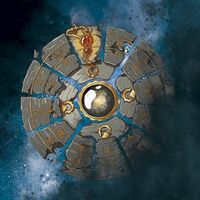
Time wizards, and Rolex (a famous and high-end watchmaker for you Iops trying to read this) backwards. The god Xelor is the one who created time and made it measurable when he descended to the World of Twelve. He created a clock by pooling a portion of reality and the Wakfu it contained then formed a swarm of bronze butterflies which formed the body and internal mechanisms of a clock. He created four more transparent ones hitched to the mechanisms for seasons, then set a magical frog to follow them around it. He set the rhythm of the frog's heart to the beat of the six Primordial Dofus, which all other being's hearts are set to as well. He set eleven purple magical gems around the outside of the clock to mark the months, then struck the ground of the World of Twelve with his magic hammer. The reverberating "tick" and "tock" onomatopoeia were placed in his pocket, then added to the clock. Finally he set aligned the seasons to the transparent butterflies. Each season's length was dedicated to one of his fellow gods: Summer for Iop, Ecaflip, and Cra, Fall for Feca and himself; Winter for Sram, Enutrof and Osamodas; and Spring for Eniripsa and Sadida. Rushu demanded in on the clock idea to make himself permanently bound to the world, and scratched a mark for December which caused black maggots to grow to slow down the butterflies and make the final month a reality (setting mortal lives out of sync with the measure of time). When Sacrier joined the ranks of the gods and was shown the clock, she made the gods feel the mortality of their followers in the seconds and shed a tear for the massive amounts of mortal lives lost down below which caused a time anomaly that causes Bonta and Brakmar to rebuild each time they destroy each other.
The Xelor peoples are chronomancers, who link themselves to the TICK TOCK mechanism of the clock to work their magic. They wrap themselves in bandages, apparently to keep from losing body parts to their warping abilities, and keep their general shape as they are prone to turning to dust as they use their magic with greater frequency. As a result, it's almost impossible to tell how old any actually are. Dofus-era Xelor dressed in robes not unlike Final Fantasy Black Mages, while Wakfu-era Xelor wear armor with gear embellishments, and masks which obscure their faces and give them a somewhat mechanical appearance. When not using time magic, Xelor are often predisposed to many kinds of craftsmanship, but most notably in the fields of making clocks, timepieces, and clockwork devices. They also seem to have a notorious propensity for losing their sanity, as at least four antagonists and enemies from across the Dofus and Wakfu era media are Xelor who have lost their minds and begun wreaking havoc in the World of Twelve. (The Mad Xelor from Treasures of Kerub, Count Harebourg of Frigost, his subordinate Missiz Freezz the Smithimagus, and Nox.)
Xelor tends to be a bit hands-off in regards to his followers. Instead, he prefers fucking with everyone else. The tabletop game Krosmaster is actually a game that consists of Xelor and some Demons (who tend to get into his realm from time to time (no pun intended), although it's questionable if they break in or are there by invitation) abducting heroes from the timeline and forcing them to fight each other for literally no good reason.
-
Xelor.
-
Xelor as seen in a Dofus animation.
-
Xelorium, the realm of Xelor.
-
Male Xelor from the Dofus era.
-
Female Xelor from the Dofus era.
-
Xelors from the Wakfu era.
-
A Xelorette.
-
Xelor himself is a dick.
-
Because Mormons don't get to stop time.
-
The names of the months in Wakfu.
-
Playing William Tell with a Xelor's hourglass isn't clever.
-
The mysterious king of the Xelors.
Iop
The name Iop (spelled I O P, not L O P), like those of most of the races in the world of twelve, is a backwards pun. "Poi" is the French word for "pea" (hence "Iop-brain" as an insult, analogous to "pea-brain"). It also happens to sound identical to Yop, a yogurt produced by the company Yoplait, for double the food puns. Iop is a fiery-headed valiant fighter with a thick beard that appears always ready for battle clad in armor. He's always looking for a challenge and in Rushu's past invasions fought him and his minions in one-on-one or even one-on-many combat. Iop is also quite dim. While being a god does come with its perks like mind-reading and the ability to scry wherever you want, he's still lower in intelligence than some mortals. In fact, arguably most mortals. He's also quite prone to arrogance and half-baked decisions based purely on what will get him into the most thrilling fight the quickest. One of such decisions was to go out into the world in a mortal form, knock up one of his followers, then just hope everything would go for the best. After a few thousand years though it did. In fact, after a particularly nasty confrontation with Rushu he passed the mantle onto that son (see Goultard above). Iop's most important personal appearance in the mortal world (other than shagging Cabotine) was stepping onto the field of battle to save a Sacrier adventurer who was fighting a villain. No prayer to him required. Additional fluff suggests this was not a one-time thing. Iop has produced demigods with mortals in the past, although it's not known exactly how many. Goultard is obviously his son, as well as his champion. At one point, Iop was seduced by one of Sadida's rogue dolls. Horrified at what he had done, he and Sadida pow-wow'ed about what to do. The beast was split into masks which were spread throughout the world. At some point in the Wakfu era, Iop incarnated himself into a mortal form. His power was inherited by Goultard, and kept safe until he needed it returned to him. After that point Goultard was entrusted to become Iop permanently.
Iop, and Iops themselves, are best described as Dungeons and Dragons Cavaliers and Barbarians. Iops tend to be fairly unintelligent, although this ranges from individual to individual with some being dumb as soggy boxes of rocks like Kriss Krass's Iop Boufball teammate, while others just average intelligence coupled with rash behavior (such as Ziza from Treasures of Kerub), and some (like Tristepin "Sadlygrove" in the Wakfu cartoon) being very intelligent in categories they deem important (Knowledge: Dungeoneering, Knowledge: Religion (Iop), Knowledge: Geography) while using WIS as their dump stat.
Physically, Iops are among the most Human of the races. They have red hair (usually), pointy ears (more like cut ears than elven ears however), usually are depicted with small or no noses, and tend to not have pupils although exceptions exist like Ziza, Grovy, and post-movie Goutlard. This may be intended to give them a wider range of expression for the audience as they are important characters, but the animated trailer for the Wakfu video game depicts a female Iop who has pupils while calm before her eyes turn milky white and bulge while she cackles in the middle of a fight. Thus it can be implied that the lack of pupils is simply a berserker state
The main organization of Iops are the Shushu Knights, an order of Goultard's disciples who use Shushus (demons) bound into objects to fight. Iops must balance the destructive and manipulative nature of their Shushu and form a common bond with them in order to unlock their full potential (which isn't hard, as the combat-loving Iops find a lot in common with their Shushu when something bigger and more arrogant than it starts trash talking). Some Shushus however cannot be reasoned with, and must be kept contained rather than used. There isn't a formal organization of the Shushu Knights, and they are of loose noble bearing (Tristepin remarks at one point that heraldry is worthless, although he places great importance on reputation of notable individuals and of stories of battle).
-
Iop
-
Iop makes himself mortal for the sake of kicking someone's ass.
-
Iop falls in love with a tranny in a sock (puppet).
-
Goultard, demigod son of Iop, and his replacement post-Wakfu.
-
Dofus era Iop male.
-
Dofus era Iop female.
-
Wakfu era Iops.
-
Pupils?
-
No wait, they went away.
-
Just because Ziza has pupils doesn't make badly edited 1d4chan pages easier to read.
-
"And Iop said; let them go commando."
-
The dumber they come, the more the Cra like them 'cause the dumb ones know how to make love!
-
Because nothing says valor like yummy strawberry-flavored bacteria paste!
Cra
Cra backwards is arc, referring to the fact that they're the archers of the setting. Culturally Cras are very regimented and srs business. Military service is compulsory, they have ABSOLUTE loyalty to their matriarchal leader, debts and honor and all that jazz, the political leanings of the kingdom are reflected in the attitudes of many if not most Cras towards those who come from that region, and they do NOT fuck around when shit gets real. Generally speaking, Cra are Israelis but without neighbors who hate them. Quite the opposite in fact, the Sadida and Cra kingdoms are very close allies which is why the princess of the Sadidas (Amalia) has a very loyal Cra bodyguard and life companion from a high noble house (Evangelyne) who grew up with her almost from toddler age.
Most Cra carry magical bows, which actually form energy arrows rather than physical ones (which they fire at a rate which would make Sisters of Avelorn gasp in astonishment). Any physical arrows a Cra employs are more likely to be trick arrows, more on par with Green Arrow (silver age comics, not television drama). While in the vidya you of course get different bows constantly (yes, Ankama did in fact employ the pun "bow job" repeatedly from class trainers) the cartoon implies that it is a great dishonor and tragic event to have your bow broken.
While most classes simply channel different flavors of magic in their powers, or while Iops simply have a Shushu of a different elemental leaning in their weapon/tool, Cras have different bows depending on their element of choice in powers. A bow that appears to be made from living plants for example may allow them to shoot magical life arrows that cause vines to appear where an arrow strikes. A bow that seems to be strung with sparks may shoot fireballs, while a bow that looks like it's made of ice or blobby liquid...well, you get the idea.
Physically, Cra resemble elves from many classic settings. They have knife ears pointy and long ears, tend towards being blond with fair skin (with adorable freckles!), are tall and lithe, and live in forests (hence their closeness to the Sadida people).
Cra's personality itself isn't known as she's had very few actual appearances in the lore by herself. Most of what is known about her is in the picture below, which seems to imply that she's the typical calm and reserved elven personality (with breast envy (which is made all the more funny when you realize that Evangelyne is the most hourglass-figured female in the Brotherhood of Tofu)).
Fluff given in the Wakfu video game implies that Cra and Iops, despite having sharply contrasting personalities, get along well together as both are strong-willed and combat-oriented classes. While this is mostly a case of fluff reflecting in-game mechanics and player tendencies, the romance between Tristepin and Evangelyne in the cartoon is nonetheless a possible indicator of Cra and Iop relations.
According to /co/ Cra females have puffy vulva due to Evangelyne's rather ample pubic mound in her Season 2 costume (this is a positive as they tell it), and thanks to her VERY ample crotch bulge in the second Boufball arc after taking a Rule 63 potion (I swear I am not making this up) the males are apparently toting kickstands.
-
Cra
-
Dofus era Cra male.
-
Dofus era Cra female.
-
Wakfu era Cra.
-
They may nag, but they make up for it in adorableness.
-
Guh ♥.
-
Hnng!
-
All the looks of an elf, but still gloriously human.
-
Dem ears.
-
Despite how adorable they are, this isn't a bad depiction of them in regards to their place in the world.
-
Like Beren and Lúthien, but less biblical.
-
Playing "Kiss and William Tell" on the second date is for Cra of low class, the rule is one month before you start getting serious.
-
Society frowns on non-lawfully aligned Cra. We know because we get treated to half a season of it in Wakfu.
-
Adorable politics, or slavery of child soldiers? You decide!
-
A mid-teens Cra. Yes, that's Evangelyne. Yes, it actually happened in the cartoon for real. No, you don't get to know the context without watching the episode.
-
Just when you thought you had long-ear genders figured out...
-
Not all Cra are paler than milk.
Ecaflip
Tie with Pandawas for the least human race in the setting. Ecaflips are the cat people, and their race name backwards "pil face" means "tail head" (like "heads or tails" coin flipping) in French.
Ecaflip is the single most involved god in the Twelve, to the point that he spent almost the entirety of the Dofus era in the mortal world as the leader of the Ecaflip race, centrally located in "Ecaflip City" (more or less one giant casino) and also managing/DJ-ing his popular romantic 80's nightclub "The Kasbah of Love". He has also produced a metric fuckload of demigods, putting Zeus to shame. In his spare time, he guides/fucks with his son and champion Kerub (the main character of the Dofus cartoon) who is immortal. Generally speaking, Ecaflip is a dick and behaves more akin to a Greek god than anything else by fucking up people's lives and claiming it was to "teach them an important lesson" while cackling about their extreme fates (both good and bad). At some point during the Dofus era, during Kerub's later years (before Treasures of Kerub) he incarnated himself in the mortal world. Ecaflip appears as a six-legged giant cat, which varies in how humanoid he can be. In the Dofus era, he resembled a white Persian with his features glowing like neon. In the Wakfu era he more closely resembles a brown Cheshire-style cat (noticeably similar to the Catbus from Studio Ghibli's "My Neighbor Totoro" actually). In the comics, he appeared as a six-armed Ecaflip with a grin that would put Conrad Veidt to shame.
The Ecaflips themselves have prehensile tails, are covered in fur to varying degrees, and come in colors and patterns that one would expect cats to appear in as well as more human hair colors. Any place humans have hair (top of the head, chest, forearms, and so on) appears to behave like typical human hair. Ecaflips have cat-like noses and sharp teeth, although they lack a snout. Different depictions show Ecaflips with pads on their palms or with ordinary human hands; this may simply be an indication of their faith manifesting in different ways and degrees however. In the vidya, Ecaflips using the water element have the ability to control their fleas as a swarm and use them to attack foes, which may be both an indicator that fleas are common nuisances to Ecaflips as well as the fact you REALLY don't want to piss one off in a domestic situation. Ecaflips have retractable claws, although unlike real cats this is more of a fingernail rather than the final digit. They also have cat-like ears on the top of their head, lacking any on the sides (because four ears would be silly). Finally, the bulk of their fur seems to depend on the appearance of Ecaflip as in the Dofus era they were noticeably more poofy compared to the Wakfu appearance, which appears to only have enough of a fine layer of fur to cause a skin tone effect. They also evidently purr and hiss depending on their mood. According to a Wakfu character named Miranda in a backstory comic, Ecaflips are stereotypically depicted as not liking rain and being afraid of lightning. The says then that it is true. This may or may not be factual as she was using it as an excuse to slip into her future husband's wagon for the night however...
Ecaflips are gamblers. In the video game, they rely on luck to fight by using attacks which can deal strong beneficial effects, or minor inconvenient ones. In the cartoon however, Kerub fights with the skill of a Rogue and only relies on luck while making risky moves (in other words, he literally behaves like he's rolling for natural 1's or natural 20's to pull off his shenanigans). While it's apparent that most Ecaflips are naturally drawn to risky lifestyles as well, this manifests in different ways. For example Miranda was a merchant who shunned the adventurer lifestyle as well as their companionship, but fell in love with and married a retired adventurer regardless and they set up their shop at a crossroads where adventurers frequent. Despite this, she still avoids the active commerce trade and mostly deals with exotic artifacts and screened wealthy buyers. By contrast, Kerub spent his entire life gambling on one decision to another and behaving like a young Scrooge McDuck. After coming to Ecaflip City and losing everything (including the wedding ring, and thanks to Ecaflip's dickery, the memories his fiance had of him) he swore to never gamble again in his life and after a difficult process of recovery and rehab for his addiction adopted a small boy then opened a shop to sell treasures from his old adventuring days. Julie, also from the Dofus series, never exhibits any gambling or risk-taking behavior other than falling in love with Simone at first sight and leaving town to accompany her on her travels.
It's a noticeable trend that Ecaflips and Osamodas seem to gravitate together like Cra and Iops. Whether this is true of the world, or just a coincidental pairing of two groups of characters from both cartoons is up for debate.
Some Ecaflips can utilize small cat-like animals called "Bow Meows" which wrap around their arms like bow-ties (hence the name).
Ecaflips have a stated rivalry with the Ouginak race (cats and dogs) to the point that Ouginaks represent bad luck and their God appears as an instant loss card in their vidya gambling moves (with a depiction of Ecaflip himself being the insta-win opposite), although the rivalry does not seem to be militant considering young Dofus Ecaflips go to public school with Ouginaks peacefully and Kerub's lifelong pursuit of the Ouginak Lou did not earn him any scorn in Ecaflip's eyes (quite the opposite, Ecaflip derived a great deal of amusement watching him throughout his life-long pursuit of her). What's interesting about this fact is that Ecaflips are 100% human, while Ouginaks are (possibly) a whole different race entirely.
-
Ecaflip in the Dofus era. Owner and DJ of a popular romantic nightclub.
-
Ecaflip takes a break to enjoy the simple life of fucking with Kerub.
-
Ecaflip as he appears in the Wakfu era. It's unlikely he's stopped being a douchebag though.
-
Ecaflip in the comics, mocking his son who is near death. How horrifying.
-
Dofus era Ecaflip male.
-
Dofus era Ecaflip female.
-
Wakfu era Ecas.
-
Ecaflips take Boufball seriously.
-
A prayer to Ecaflip.
-
Ecaflips have a minimum class requirement Dexterity of 18.
-
An Ecaflip and her Bow Meow.
-
-
The MILF with the most, Miranda.
-
-
Dayum!
-
Ecaflip City.
-
Goin' on an adventuh'!
-
Kabrok the adventurer Osamodas and his future wife Miranda.
-
Blue on brown love.
-
-
-
Roll a disguise check, remove all results that aren't 1 or 20.
Eniripsa
Eniripsa are the healer class of the game (Eniripsa=Aspirin). Like Cra, the god Eniripsa is one of the more restrained gods, which means like everyone else who doesn't go full retard and pop into the mortal world for lunch Eniripsa doesn't have any major appearances in the mortal world.
Eniripsas themselves are primarily alchemists and magic wielders. They range from the maniacal cackling mad scientist (damage oriented) to the saccharine sweet nurse/doctor (healers proper) although their (rare) appearance in the comics and cartoons are in the latter role as the stereotypical fantasy magical healbot. Their role in the vidya isn't much different, being notably similar to Warcraft priests. Overpowered damage, or healbots doing their role and nothing else lest they incur the wrath of the martial classes.
Their physical bodies aren't any different than humans, other than wilder hair colors/styles and having wings. The wings in artwork are wildly different in design, from leathery dragon wings to transparent dragonfly wings to floating bones to feathery angel wings. The size also differs greatly. Their default is small butterfly wings however. They are depicted as hovering with them, although artwork shows them flying as well.
Along with Sadidas, they are the primary healers in crunch (although the often underpowered Sadida are glossed over by min/maxers). As Ankama enjoys connecting the fluff with player habits, Eniripsas are more connected to the natural world in Wakfu lore by emphasizing their alchemist roles in the world.
-
Eniripsa
-
Dofus era Eniripsa male.
-
Dofus era Eniripsa female.
-
Wakfu era Eniripsas.
-
The various Eniripsas seen in the Wakfu cartoon. All as healbots.
-
Don't call them fairies.
-
Eniripsa children's books.
-
Silly healer, standard bearers stand in the front rank! Put the flag down and heal the real fighters.
-
Get used to that, because it's what you'll be doing for the rest of your life!
-
The personality of the average Eniripsa.
Feca
The name "Feca" comes from "Cafe", although there's three explanations for as to why this makes sense. The first is that the first three classes designed (Iop, Feca, and Sram) were just named after food. The second explanation is that as the hipster class, Fecas have a coffee shop personality. Finally, there is a joke about the fact that early incarnations of Fecas had relatively long fights due to their mechanics, leading to the claim that ample coffee is needed to stay awake playing Fecas.
Along with Eniripsa, Feca are the most neglected group in fluff. None have ever made a major role in a comic or cartoon from Ankama, and in the game their plot is minimal. Rare is the Feca you can see in the background.
Physically, they're human. Flat out ordinary humans. Wonder that they get in terms of powers for worshiping Feca as their goddess? Insatiable curiosity, the need to poke their nose into everyone's business, and a working knowledge of magic items. That's it.
Feca get to identify magic items and their properties as a free action as many times as they want per (small measure of time), and anything important or powerful that wasn't made by Eliatropes, gods, or Rushu (the few times he's ever made something) was probably either made or owned by a Feca.
Wanna know what the requirement to be a Feca is? Being a Paladin. That's right, in exchange for mastery over gear and loot you have to adhere to a very strict Lawful code of conduct and live a life of self-sacrifice. Internet white knights and moralfags trying to ruin your Magical Realm fantasies with their refusal to fall who get patted on the head by GMs for helping load everyone up on the railroad get to be Fecas. Feca herself must be pretty cool then, right? Who knows! Feca is the god with the least amount of fluff to her. We know she rigidly adheres to a martial-oriented rigidly good aligned discipline, and expects the same of her followers. The most we know of her is that she created the robotic race of Mechasms while she and the other pre-god Spirits were traveling the Krosmos. Many years later, she had a son (with who isn't known) named Otomai.
Otomai spent his time protecting the world, claiming Dofus and hiding them to keep them out of the hands of pesky adventurers who would use the things that make the sun rise and summer turn to fall in order to win sporting events and pick up chicks. During this time he became known as one of the greatest heroes in the world, and refined the art of Alchemy into perfection as well as learning monk-like martial arts. Within his Haven Bag lies hundreds of magical potions to do whatever he wants, and can transform into a talking blue bird at will. Eventually he discovered one of Sadida's Dolls, Dathura, who had "died" when her crystal heart made of pure Orgines (solidified Wakfu) was destroyed. While attempting to forge a new one for her, he accidentally created a creature of pure Ogrine when his tiny alchemical servants dropped candy into the mix. This creature, Ogrest, became his son and went on adventures while attempting to resurrect Dathura himself. Eventually he succeeded as Ogrest's tears transformed a sapphire in the shape of a heart into an Orgine heart replacement. Dathura wasn't the lovely maiden both thought her to be however, and manipulated Ogrest into claiming the strongest of the Dofus Otomai had hidden. Otomai was forced to oppose them, leaving Ogrest feeling abandoned by his father and paving the way for thousands of years of misery for everyone in the world. Eventually the two made up when Otomai, Iop reborn, and the god-king of the Eliatropes all stood against Ogrest and the first six Dragons of the World of Twelve which lead to the end of Ogrest's Chaos, the return of the childlike form of Ogrest and his making up with Otomai, and Iop losing an arm but finally learning to be responsible.
tl;dr Feca is to blame for everything bad that has ever happened except a few much less cataclysmic things Rushu, Sadida's soul fragments, and Iop's penis caused.
Despite the focus on frontline tactics they employ, Feca are not offensively oriented. While Iops prefer to get into a fight and let their hit points and armor do the talking, Feca utilize magical shielding with energy manipulation to deal damage. In D&D terms, Fecas are psionic artifact-bearing monks. During the Dofus era, Fecas used much more of their own magical strength to achieve their goals. Wakfu sees them as better equipped, having traded their magical staffs for magitek equipment that's a half step away from being Tron inspired.
Also, NEEEEEEEEEEEEEEEEEEEEEERDS!
-
Feca
-
Dofus era Feca male.
-
Dofus era Feca female.
-
Wakfu era Feca.
-
The Feca king and his servant.
-
Otomai in his youthful years in the Dofus era.
-
The older Otomai.
-
Otomai in the modern era.
-
Otomai's bird form (after an inelegant arrival).
-
Play the nerd you are in real life in a vidya, just as decked out in magical crap as your Warcraft character! What's not to love?
Enutrof
Enutrofs, derived from "Fortune", are the Dwarf stand-in for the setting. Like Dwarfs, they are a mining race fond of axes (which are also shovels!), are deeply familial and clan-like, prize gold and gems greatly, tend to land somewhere between grumbling 80-year old man and loving parent/uncle, and make great murderhobos adventurers.
Unlike Dwarfs, Enutrofs do not have an ethnic accent, do not live mostly underground (although their basements are still massive gold holds), they get along well with Cra (or at least as well as anyone else anyway), they do not have a default Lawful alignment, are not Steampunk enthusiasts or master crafters, do not resist or have issues with magic, they are as tall as any other race and tend to be lanky rather than stout (although stout Enutrofs do exist), and they have no particular issues with goblinoids or dragons.
Quite the opposite in fact; their god Enutrof is a shining metallic-scaled Dragon Spirit. Why humans who worship a Dragon look like old people once they hit pubescence is a mystery though.
Enutrof's dogma is a strange one. He preaches that great wealth is the best thing in life and ties the health of his followers directly to their net worth like classic D&D Dragons, although much of the magic he grants his them uses gold (minted into coins called "Kamas" which are the standard currency on the World of Twelve) and gems as a spell component. Indeed, when one of his mortal champions and mayor of the largest Enutrof city Ruel Stroud (and the rest of the Brotherhood of Tofu) were about to be consumed (as well as Ruel's entire family fortune) by an evil genie, Ruel made a desperate plea to Enutrof for divine aid in exchange for doubling his yearly tributes. Enutrof became the only God to appear in the Wakfu cartoon by appearing to say "Zero times two equals zero, Ruel. You can still run." and vanish (of course, Ruel skipped offering to begin paying and went right to the suicidal last stand option). Of course as the god who created wealth, tributes are only symbolic to Enutrof.
From this, it can be surmised that Enutrof values capitalism and shuns hoarding behavior, preferring a Reaganomics "greed is good" outlook of rapid acquisition and equally rapid use (although Enutrofs spending freely seems to be a rarity outside Alibert's generosity ). This explains the treasure-hunting/steady work behavior of most Enutrofs in canon.
Although Enutrof tend towards being greedy grumblers (with Ruel proving the stereotype throughout Wakfu), it's not a rule (no pun intended). Alibert, the adoptive father of Yugo in the Wakfu series, made his first appearance refusing to bring in a man who stole food for his family for the bounty on his head. Upon having his soul viewed by Grougaloragran from a distance, the old Dragon saw that he was a pure and good being, causing Groug to trust him to raise Yugo to be a good man as well. Alibert retired and opened a profitable inn, and later in the series cares for the infant Chibi and Groug reborn without complaint (although doing so in the company of the Sadida royal court, where he befriended the aging Sadida king, may have been a perk).
Enutrof lifespan is unknown. Technically they are mortal Humans, but Ruel is 200+ years old. His grandmother, who appears little older than him, is in a season 2 episode where she claims that he's not an old man and has been pretending to be one to get out of work "since his teeth fell out". In Ruel's childhood memories from the same episode, his younger self appears to be a normal child of 10-ish age with his grandmother still looking the same.
Enutrofs in the vidya are a multi-role class. Most people keep one by default in the party since a water spec Enutrof increases the loot drop rate from enemies. But Enutrofs can also be a buffing class (worth mentioning that Ruel was a rock star at one point in his life), a powerful melee and spellcasting class (so a Spellblade), and a summoning class that rely on small boar-like animals called Drhellers to help them fight (which at high levels can merge with the Enutrof to become a giant beast called a Drhellerzerker temporarily). According to the Wakfu cartoon, Drhellers and Enutrofs are almost never found apart (although Alibert, Ruel's grandmother, the Enutrof princess, and Enutrof pop star seen during the series all lack one).
During Ogrests Chaos Enutrof contributed alongside Osamodas and Sadida the most to the new world by providing "Haven Bags". While Haven Bags are primarily an in-game mechanic rather than proper fluff, they are nonetheless present in the canon. Haven Bags are a cross between a pocket dimension and a Bag of Holding. Players use them to build their own homes and later realms, one small patch of land or piece of furniture at a time. These homes can be used to sell items to other players by leaving your bag someplace where other players are located, who can then pop in and peruse your inventory like you are an NPC merchant. A Haven bag is seen used in the Wakfu cartoon, but only by the Enutrof Ruel Stroud. No other characters are seen carrying any, and other characters do not seem to have preexisting knowledge of the system which may mean that Haven Bags are owned mostly by seasoned adventurers only. In the vidya however, players receive one for free upon swearing allegiance to a country (apparently in the Wakfu universe, haven bags come free with a welfare check).
-
Enutrof
-
Artwork of Enutrof.
-
The basement of Enutrof's main temple in Bonta.
-
A statue of Enutrof.
-
Dofus era Enutrof male.
-
Dofus era Enutrof female.
-
Enutrofs, AKA Dwarfs. Enutrofs in the Wakfu era.
-
Another Wakfu Enutrof.
-
Dammit /pol/, this is why we can't have nice things.
-
Even if he has a bad dream, he'll wake up happy.
-
Enutrofs have different ideas of beauty. It's the only way they could reproduce.
-
The evidence to the above statement.
-
The rarely seen Enutrof loli. Yes by the way, she really did sing that in the cartoon. Based Bretonnia.
-
-
Dhrellers as seen in the vidya.
-
Ruel's Dhreller.
-
-
-
Don't ever think that because Ruel chooses to run that he can't fight.
-
The young Ruel and Alibert, with an un-aligned human.
-
Present time Ruel and Alibert.
-
The inside of a Haven Bag. Thanks to Enutrof, you can take the comforts of home wherever you murderhitchhike!
Sram
Srams are the third class to derive their name from food, as Sram backwards is Mars. For 'murricans, Mars is the name of a large candy company in Europe. They're the company that makes M&M's, among many other sweets you could probably find in an import store (or up north in Beaverland).
Srams don't have a lot of fluff to them, nor does their god. Despite his seemingly evil persona, Sram is counted among the Ten and is at least less evil than Rushu. More likely he is patron of sneaking rather than the result of their behavior towards good or evil.
Srams themselves are assassins and thieves, fighting using a combination of traps and sneak/"SURPRISE ATTACK MUTHUHFUCKUH!" abilities.
Sram has few actual demands of his worshippers, so the only requirement to be of his faith may be to want to worship him and fight like a Sram. In the Dofus era, Sram males were skeletons (2spooky!) while females were ordinary humans that just wore stripper-inspired Halloween outfits and a cloak. How they reproduced isn't clear. In the Wakfu era, they now both wear skin-tight skeleton costumes with males wearing skeleton masks and females wearing veils. During the time since Dofus they have "become more mysterious". Which basically means showing their face is now taboo.
Rogues are an offshoot of Srams. Originally bandit monsters for players to fight, they received a class and storyline in later updates to Dofus. Rogues receive no magical assistance from Sram, and are physically normal humans. Their storyline involves a family of Srams, called the Smisse, breaking off and forming an organization who utilize the underhanded tactics of Sram but without the finesse. Instead, they are loud and forthright in combat preferring to use guns, bombs, and in the case of the heir to the Smisse bloodline Remy Smisse the use of Shushu weapons stolen from Iop Knights who met...unfortunate ends when Remy and his brother Grany (later turned into a Bow Meow and usually present on Remy's shoulder) were in town. Unlike the other classes who run the alignment gamut (they're humans after all), many (but not all) Rogues are evil and the bulk of their race is found or based in Brakmar. The only loyalty of Rogues is to the Family. Sram himself, civilians, allies, everything else is second.
-
Sram as worshipped by Srams.
-
Sram as worshipped by Rogues.
-
Dofus era Sram male.
-
Dofus era Sram female. Wait, what?
-
A Sram female from Treasures of Kerub.
-
There's a skeleton outside him.
-
Wakfu era Sram.
-
The Brotherhood of Tofu in skullface.
-
-
He's big boned.
-
Srams do it from behind, or they get it there!
-
Dofus era Rogue male.
-
Dofus era Rogue female.
-
Wakfu era Rogues.
-
An old Rogue girlfriend of Kerub.
-
Rogues give the booty the respect it deserves.
-
Rogues do still retain some of the secret techniques of the Boner God.
-
Remy and Grany Smisse, technically heirs to the leadership of the Rogues (as much as they have leaders).
Sacrier
Unlike most classes, Sacrier has two different names for French (Sacrieur) and English. Both combine the root "sacrifice", with the English one combining "cry" and the French "rieur" or "laughing". This naming describes the goddess and followers pretty well. Her domain as a whole is physical and emotional pain. On one hand, there's the emo followers who shoulder the pain of others (the tanking spec) and play nice with the other races of the world. The other is the sadistic side (damage spec) whom your struggles excite, who have a decidedly punk rock/chav feel to them.
Sacrier was a very small and weak spirit who followed the nine gods who came to Osamodas's hangout spot. She watched the world evolve around her, and saw misery and pain everywhere she looked. Shortly before or after Xelor made his big magic ticky-tock, she came to dwell in a forest near civilization where she observed a poor woodcutter every day struggling to earn a living. She whispered soothing words to him, encouraged him, and lent him strength as he worked past bleeding and exhaustion every day. After some time, he began to consciously hear her. He was grateful to the mysterious voice, and for a time she was his ever-present companion. She told him of the things she had seen as he worked, of the dead and dying on battlefields and the suffering of those who became lost in the savage parts of the world and perished hungry and alone at the hands of vicious beasts. As he listened he mourned those of whom she spoke, and though the pain that wracked his limbs and soul was great he was able to do the work of ten men and more without flinching.
Eventually, spirit and man left the woods to seek out more people to share their depression with. He became her prophet, and spread her word throughout the world. Those who listened found themselves empowered by their own weakness. Some like the lumberjack used the knowledge that there's starving children in Africa the world to become productive members of their communities. Others saw a cult of dudes who can lose a finger and use the pain to crush diamonds and went "OI, DAT'S PROPPA' FUCKIN' AWESOME MATE! LEMME IN ON DAT SHIT, OI'M SICK'A HAVIN' TO STOP PUNCHAN' BLOKES WHEN ME KNUCKLES AH' BLOODY!"
With all the faith surrounding her and a few generations of reincarnating souls picking her as their patron before leaving Incarnum for worldly wombs, Sacrier grew to become a great spirit who caught the notice of the Ten on Mt. Olympus Zinit. They offered her to become a member of the pantheon, and she accepted.
Rushu, who had recently been convinced to leave the World of Ten with a bullshit line about "balance between Stasis and Wakfu entities" was NOT amused and swore he would consume Sacrier and the souls of any who followed her.
Due to (or perhaps a coincidence unrelated to?) Rushu's rage boiling over, Brakmar marched to war against Troy Bonta. At the same "time", Sacrier was being given the tour of Mt. Zinit by the other gods and had reached Xelor's Clock. As she looked it over, she saw the fate of Bonta and Brakmar to destroy each other in the conflict raging below. She shed a single tear for the genocides to come which fell into the clock which startled one of the metal frogs within who chased the metal butterflies who keep time moving forwards. This caused a ripple in time which on the eve of the destruction of the twin cities shifted a paradoxical reflection of the past glory of the cities at their height within her tear back into reality. The conflict was reset back to the state where war began, but with all the memories of the bloodshed it caused. The two sides quickly came to an "uneasy" truce which, barring skirmishes here and there, has held. While this might seem like the setup for a two-faction MMO, Brakmar and Bonta remain at peace while player-made and run factions wage war instead.
Sacrier appears as a winged fey being the size of a human (or larger) who's arms are bound behind her back. She sometimes appears in the mortal world to save or comfort the dying. She also graces the spirits of those who survive them to avenge the fallen.
Sacriers themselves are usually red-headed and have Keeb Cra ears. Otherwise, they appear completely human. The magic their faith grants them converts pain and wounds into strength and buffs. As a result, their main strategy regardless of role is to leap straight into close combat and stay there. They possess a metric fuckload of hit points in the vidya, and unlike the classic tank role they can wind up doing more damage than other members of the group when the healer falls asleep.
They also utilize blood magic to pull off stranger effects, like teleporting around the battlefield and reducing damage taken by themselves and others.
In the Dofus era Sacriers used their own blood to work magic and form temporary weapons. In the Wakfu era, they have taken to using magic tattoos instead although they still use pain and blood in their spells as components (simply not the form of the end result).
-
Sacrier
-
Sacrier in the comics.
-
A statue of Sacrier in Incarnum, where souls choose which god to worship before being born.
-
Another Incarnum statue of Sacrier.
-
Dofus era Sacrier male.
-
Dofus era Sacrier female.
-
Wakfu era Sacriers.
-
-
Kriss Krass, a celebrity Boufball star Sacrier.
Pandawa
The second race added to the Dofus vidya after launch. If you don't know where the name comes from, please find someone who isn't a Iop to explain it to you.
As you might expect, Pandawa come with a slew of Chinese stereotypes; the females wear dresses resembling Qipaos while the males dress in Asian inspired peasant garb, names tend to sound very Chinese (and East Indian), and their culture and architecture appears to be that of southern Chinese inspiration. They are described as "Sherpa" people however, and the village shown in the cartoon was located close to a mountain range making Pandawa at least unique among the trinity of computer-generated panda people from the 2010's for not being 100% Chinese influenced. Although some have Engrish accents, Wakfu shows amazing restraint in having many Pandawa have the same regional dialects as the other races in the game.
Not long after Sacrier became a goddess, a simple spirit named Pandawa who had been experimenting to find a new way to make cheap and good alcohol for whatever reason figured out an easy way to make decent wine from bamboo, and in bulk. She found like-minded folks who dwelled in regions with ample amounts of bamboo and taught them how to make it. As the first bamboo wine-making families came into prominence Pandawa's image adorned the casks they made. As the booze-swilling forestfolk incorporated bamboo wine more and more into their culture, Pandawa herself became an important figure in their lives as a being to toast before a drink and to thank for her great gift when sampling new brews. With all this attention, Pandawa found herself becoming more and more powerful, and she channeled that power into furthering the vinting and fermenting techniques of the people. As she shared her new discoveries with humanity, those who benefited the most began to live like her and practice serene lives consisting of hard work at wine-making, and their descendants began to look more and more like the godling panda. With prosperity came conflict from raiders and monsters, so the brewers quickly learned to defend themselves in their work attire using only the tools available rather than ideal combat garb and armament. As a result modern Pandawa utilize barrels as weapons. At one point (it's not clear how long, or if she became a god before or after being invited) Pandawa became a god proper and joined the pantheon of the Eleven, making them the Twelve. Pandawa herself is a mellow spirit who like Ecaflip prefers to dwell amongst her followers. Unlike the mischief-causing Eca though, Pandawa leads people and aids them in their efforts to refine the process of brewing and of enjoying good (and cheap) alcohol. She appears to be the same physically as her mortal followers, looking like a a human/panda hybrid.
Pandawa are monks plain and simple, utilizing melee combat with a combination of blocking and using their booze kegs or hollow bamboo canteens (which few are ever without) to drink different vintages to gain effects in combat like resistance to pain and damage or the ability to breath fire. They switch between a drunken and a sober state rapidly in combat to utilize different magic attacks, and possess great physical strength that they can use to hurl players and objects around the battlefield with accuracy. Pandawa villages are spread out throughout the world, but are almost always found where there is bamboo (natural or introduced) barring adventurers who can of course be found anywhere.
Unlike more recent media depictions of panda people (by Dreamworks or Blizzard), Pandawa are no more or less prone to obesity than other races. They are in fact usually shown in artwork as having slim limbs and being tall. Whether this is to discourage comparisons or simply the intended design is up for debate.
-
Pandawa
-
Pandawa in the mortal world overseeing the booze industry.
-
Dofus era Pandawa male.
-
Dofus era Pandawa female.
-
Wakfu era Pandawas.
-
Go for it, you're not a furry. She's human!
-
Not that it'll stop the trolls.
-
The policlubs make their stance clear.
-
Handling your ale, being stalwart and unafraid, and being able to breed outside captivity are all turn-ons for a Pandawa.
-
-
Although Pandaren predate Pandawa, Pandawa managed to get them into an MMO first.
-
Canon nude Pandass from the Dofus magazine.
Eliotropes (Yugos)
Spoilers in this, but in the special OVA episodes of Wakfu that takes place after the comics (which take place after the second season, all together 6 years later) Yugo accidentally fucks up the time stream for a moment during his "defeat" of Ogrest. But it's just one moment, what's the worst that can happen, right?
Well, humans all over the world around the Dofus era caught a glimpse of the awesomeness of a two-time soccer football BOUFBALL champion...who also did other, less important things like save the world four times and be the firstborn son of the gods that created reality or something. As a result, humans began to worship him as a god.
Because of this, in both vidya games the new race of "Eliotropes" (notice the swapping of an 'a' for an 'o') humans are being added, using Eliatrope portal physics and revering the God Emperor of the Krosmoz.
What this means for the canon is unclear; were humans back in Dofus empowered by the Wakfu of his fetus-self inside his Dofus in Grougaloragran's care? Will he be made part of the pantheon, making it the Thirteen? He's got a good hook-up what with being close personal friends with Iop and all. Are the Eliatropes similar in soul-properties to spirits in that they can become gods with worship? It's possible, as the same amount of babby-making effort that made all of reality plus all gods and all demons was what it took Eliatrope and Great Dragon to make the six immortal Eliatropes and six immortal Dragons. Will Yugo return to a completely different timeline with no memory of what changed? Does he get new powers?
At any rate, the addition of Eliotropes was foreshadowed in Krosmaster; in the second release of miniatures, there were Eliatrope-like characters. Krosmaster is actually canon within the Wakfu universe, so it seems that Xelor was not pulling characters from before he made his clock but instead from the future (or past and present with future simultaneously, as Krosmaster sort of seems to exist outside of time).
The appearance of the race seem to take on the look of Adamai, having white and blue skin. They wear hats like Eliatropes, although we won't likely find out if they have head wings anytime soon.
His description in the image below translates to this: "The God-King, The Mysterious Monarch, The Spiritual Father, The Benevolent, The Emerald Guardian. His virtues: Courage, Loyalty, Altruism, Sense of duty. His magic: The current of life, Wakfu, eternal and cyclical. His divine attributes and accessories: The sword and shield of Wakfu, The royal Hat. Symbol of his followers: The Portal. Praise the God-King, the protector of Eliotropes!"
-
-
The God Emperor protects!
-
Eliotropes in artwork previews.
-
The current vidya model appearance of Eliotropes.
-
A Krosmaster Elia/Eliotrope
Demons
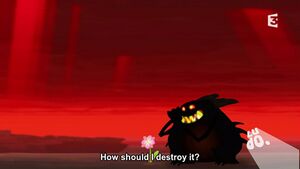
The race of Demons are the polar opposites and equals of the Spirits and Gods in the Wakfu setting. Although not technically inherently evil, Demons are born to destroy as they are formed of Stasis (Wakfu AKA magic energy that has transitioned to a low-activity state (although Wakfu can become a solid and remain Wakfu, while Stasis can take the form of heat and not become Wakfu; the details of what causes one to become the other are not known)). The evil of Demons came after they adopted the worst traits of humanity (there was a time that the idea of killing parents and sparing children so they would be orphans was Lovecraftian to them). Rushu came to embody evil, surpassing every example of it he saw. Others only emulate Rushu while in his realm, and left to their own devices become mischievous and almost fey.
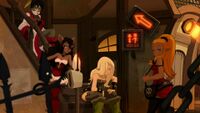
Demons (and humans who worship Rushu) can be contained in magic items (these demons become known as "Shushus", which makes translation of the series interesting as northeastern European countries use "shu shu " as slang for the need to urinate. Whether this was an intentional joke or not is unknown), granting great power to the wielder. Some items only become more useful (magic talking maps that reflect the daily changes in geography Ogrests Chaos causes, rings that produce illusions and mind-control others, and talking cupcakes that are automatically your favorite flavor (seriously)) while the more powerful Shushus become weapons. Shushus must choose to use their powers however. Whether trickery is required, or threat of violence, or even a mutual goal is needed varies from Shushu to Shushu.
Very few Demons are intelligent, with personalities akin to the most clever Orks being the norm. Furthermore, most have an arrogance that would cause an Eldar to shake his head in disbelief.
Rushu
Rushu is the sole member of the Demonic equivalent to the Ten/Twelve, having consumed all of his siblings but one. As a result, almost all other Demons are fairly low in power compared to him and can be fought by mortals.
Rushu seeks to become a god in the World of Twelve, where he would have an infinite amount of things to destroy for his pleasure. Through his manipulations, he managed to create a cult of humans to worship him who would establish the kingdom of Brakmar in Rushu's honor. Although once a place not entirely different from a Chaos Space Marine vacation spot, the intervention of Sacrier to save it in the Dofus era caused it to normalize. At the point of the cartoon, Brakmar is more Gotham City than Gomorrah (or worse; Hub City). Criminal organizations are usually based here, prostitution is one of the biggest internal economies, and every bar is a dive with as much blood as puke and spilled booze on the floor. Whether it was cause and effect or merely coincidence, Rushu himself became more hedonistic in the Wakfu era as he waited for an opportunity to attack the world rather than seeking one out.
As Sacrier became a God after Rushu was tricked by the Ten into leaving the World of Ten, he harbors a special grudge against her and her followers (some Demons and Shushus do as well). He strangely does not seem to feel similar ill will to Pandawa. It's possible that not even Demons can hate cuddly pandas and good wine.
In the OVAs of Wakfu, Rushu has (once again) been beaten by Goultard, his unconscious body being used as a foot rest while minor Demons fan the crazy Iop.
-
Rushu, in his assumed form.
-
Rushu after consuming his minions and getting serious.
Mongrelamus
The only surviving of Rushu's brothers, Mongrelamus was the weakest. He fled early in the universe to the World of Twelve, and possessed hero after hero while keeping a low profile. His life in the world exposed him to mankind's evil 24/7, and he became even more cruel than Rushu. Mongrelamus would eventually possess a Sacrier hero, then kidnapped Goultard's wives and children to lure him to a fight. Goultard came too late to save them, and in his rage beat the Sacrier to death. Mongrelamus possessed Goultard then, but the demigod was too much for him to control. Goultard's personality split from Mongrelamus's evil influence, and the wicked "Dark Vlad" personality was born. As Dark Vlad, Goultard wandered the world slaughtering like a Bloodthirster until heroes from Bonta managed to defeat him. Mongrelamus's fate isn't known, but it's unlikely Goultard let him go free after what he caused.
Anathar
Second in command to Rushu, Anathar is the only being who can rival him for the title of "biggest asshole in the universe" (Xelor and Ecaflip are excluded from this on the technicality they are dicks, not assholes). Bound as a Shushu at an unknown point in time, he completely refused to be wielded and instead possessed every being who tried to wield him. Even the Shushu knights were unable to contain his power. It fell to an order of paladins to keep him contained.
During the Wakfu cartoon series, Anathar is released by the Rogue Remy Smisse in an attempted diversion to cover his escape. Anathar single-handedly opens a portal to Rushu's domain, allowing his master and the rest of the Demon race to waltz into the world un-hindered. Anathar then possesses Adamai, and aids the evil Qilby in his fight against Yugo. Adamai eventually shakes off Anathar's control. Anathar has the ability to copy magic attacks used against him with substantially more power than originally used. This is shown when Yugo throws him through a portal, and he immediately uses multiple portals at once to counterattack (something only Qilby while hopped up on Wakfu could do at that point).
Anathar is a Demon who resembles an evil jackal, although he later on takes a more draconic form after his possession of Adamai.
-
Anathar the Demon.
-
Anathar possessing Adamai.
Djaul
Another draconic Demon, Djaul was appointed by Rushu to control the month of December and wage continual war against the other month guardians in an effort to expand his domain. He fights the female guardian Jiva (January) for control every year. Leap years result when Djaul almost beats her, although he has yet to win a battle. The constant war has begun to drive Jiva insane however. Djaul appears as a Demonic Dragon, or a muscular gargoyle-like humanoid with dark skin and red eyes.
-
Djaul the Black Dragon.
-
Djaul and Jiva fight over the fate of the New Year.
-
The occurance of a leap year.
Ombrage
A rare female Demon. Ombrage has the power to steal the shadows of mortals, turning them into Ghouls which serve her without question. She seduced her Iop Knight guardian Wagnar through the ring that bound her and took over his body (renaming him Vampyro, then conquered a town before she was beaten by the Brotherhood of Tofu. In season two, she escaped her ring prison and imprisons Wagnar, took over a whole kingdom, and teamed up with the independent Rubilax to open a portal to Rushu's realm. Her and Rushu's mockery of Rubi however caused him to betray them. Ombrage was once again trapped in her ring, with Wagnar abandoning her on the floor of her throne room alone. She has since found a new master/puppet, and will likely appear later in the series
Rubilax
One of the most powerful Shushus, and the single least respected Demon. In his natural form, Rubilax is a stone-bodied humanoid with glowing red and white eyes. As he is attacked, he grows in size and becomes more powerful. In /co/'s description, it's the "Hulk VS his weight in bees" scenario; you can't beat him in a long fight because the closer you get, the stronger and denser (and more unbeatable) he becomes. His Shushu prison is a dagger, which grows as large as he wants to grow and swaps between fire and earth powers.
Despite this, he has emotions comparable to Spirits and Humans. He even forms a friendship bond with his guardian Tristepin over the course of the series (after four times possessing him and almost killing people close to him, and twice trying to physically kill him). Even powerless Demons of literally NO standing mock him openly. At some point in the past, Goultard beat Rubilax and he begged for his life. Goultard spared him, and had a master smith form his blade prison. He kept Rubilax (who at one point was seen in the background hanging from Luis in Treasures of Kerub) until he found a Iop he could trust to control Rubi. Said Iop wound up being his own apprentice, Percedal Tristepin.
Rubilax's main role in the series is "sarcastic remark character", which sometimes results in his dagger being bashed against a rock or into the ground by Tristepin. /co/'s fancanon involves "Uncle Rubi" giving sagely wisdom (some of which is encouragement to misbehave) to Grovy and Eva's children when not undermining papa Grovy's authority.
-
Rubilax, blade of Tristepin.
-
Rubilax and Grovy's typical exchange.
-
Rubilax having possessed Grovy's body.
-
Rubilax's true face.
-
Rubilax and Grovy preparibg to fight a Demon army.
-
Grufon
A very weak Shushu, unworthy of a Iop guardian (he still mocks Rubilax every chance he gets though).
Grufon's true form is that of a small Demonic goblin creature, although he possesses a spider at one point. He is bound to a scroll, and his power is to be a perfect map of the world (think global Marauder's Map, but without tracking people. Just places). While early in the series he refuses to help unless complimented whereupon he misdirects often until threatened, and at one point attempted to kill the Brotherhood, Yugo agrees to be his guardian (giving him a reputation boost as a Demon). For the rest of the series he is cheerful and helpful (when not mocking Rubilax).
-
Grufon the Shushu map.
-
Grufon in his true form.
Luis
A Demon who possessed Kerub's house. He has a personality similar to Grufon along with Rubilax's pride, although his only mischief is in making Kerub's shop a mess and difficult for Simone to keep clean. Any actual benefit to having a Shushu house is unknown.
Non-human(?) Sapients
There are a number of non-human races in the World of Twelve, although exactly WHICH ones are other races isn't exactly clear. Due to the morphic nature of mankind in the setting, along with the fact you don't have to worship one of the Twelve (just any spirit actually) it's hard to tell by look who's human and who isn't. In the video games, the classification of "monster" applies to anything hostile from man-eating plants to human cultists and bandits. While you would think that things you can take food and gear crafting materials from would be monsters, part of the setting's black humor is how murderhobos view everything that moves as food and XP (including sometimes each other). It's possible that this is the disconnect between video games and the rest of the setting.
Races oftentimes appear alongside others races as citizens throughout the world with equal rights to humans, going to public schools (where such a luxury exists), finding employment, and visiting recreation like sporting events and clubs. For all intents and purposes, anyone who behaves human may as well be human for all the difference there really is. Regardless of that fact many of their kind remain in the wild as killable monsters.
Ouginaks
Ouginaks are one of the races of dog-people in the World of Twelve, alongside Boowolves.
In Treasures of Kerub, Ouginaks are treated exactly as humans while in the Dofus video game they fulfill the role of Orcs as a mid-strength enemy to beat in a few areas close to Brakmar. In the game you can loot several items from them including their lips (which has a bit of flavor text that Ouginaks are known for gluttony), their hearts (which says they are known to be loyal), their eyes (which says you see your doppleganger instead of your reflection in them), their hair, collars, and chains (both of which imply that the Ouginaks you fight in the game are enslaved by Brakmarians rather than actually intentionally hostile to you). Out of these items you can craft weapons, clothing, and edible goods. How horrifying.
Dofus video game Ouginaks resemble Disney Goofy-style dog men, while Ouginaks in the Dofus cartoon look like Ecaflips with long ears in the style of a Saint Bernard while lacking tails. Interestingly, this makes Ouginaks more human physically than the Ecaflips. Ouginaks are described as not getting along with Ecaflips and in Ecaflip's gambling magic the image of the god of Ouginaks (of whom we know nothing) represents an automatic loss (contrasted with Ecaflip's own visage, which is an automatic win). The only portrayal of this rivalry in media however is the young Kerub's rivalry with his Ouginak opposite Indie, and his occasional squabble with the Ouginak love of his life Lou.
In the Wakfu era, Ouginaks have not been seen or mentioned in the comics, vidya, or cartoon. This has lead to many within the fanbase to theorize they were fully wiped out by Ogrests Chaos. Since there is no lore confirming or denying anything regarding Ouginaks at all, it remains only speculation.
Unlike Ecaflips, Ouginaks appear to be very ordered; Indie oftentimes plays it safe while Kerub undertakes risks. Lou is infuriated at Kerub's broken promises more than his actual actions (at one point throwing him in jail just to make sure he remembered their date that night), she kept order and at one point in her life became a duly elected judge, and utilized powerful magic artifacts...to practice dancing on schedule. This, with the flavor text about Ouginak eyes in the vidya, have lead some to hypothesize that Ouginaks are actually humans worshiping a god who is related to Ecaflip or possibly a heresy of him like Rogues and Masqueraiders.
It is unknown if a human and Ouginak could breed. What is certain is that Kerub and Lou probably had fun trying.
-
A depiction of the god of Ouginaks on a playing card used by Ecaflips.
-
Ouginaks as originally seen in the Dofus video game.
-
The one on the left is a glorious human warrior. The one on the right is a Gnoll. Welcome to Wakfu.
-
The young Lou.
-
Lou in her twilight years.
-
Kerub had taste.
-
The two in the middle are Ouginaks. You if you can't tell who's Eca and who's Ougi, watch for the frequent use of dog jokes that will inevitably pop up to differentiate.
-
Ouginaks hold down many professions, from Professional Pirate...
-
...to pop culture icons.
-
Kerub and Indie.
Puddlies
Puddlies are small and friendly ooze monsters that dwell on the outskirts of civilization. Being somewhat like Hobbits, they are farm folk who require the aid of other races in most cases to protect them. When frightened, they liquify back into oily-water in the same manner a possum faints. The more frightened they are, the less solid this water is.
Like Hobbits, they seem to stay away from human civilization and instead stay within their own sheltered communities.
-
-
-
Puddlies praise the sun!
Minotaurs (Minos/Taurs)
The Minotaurs of the setting. Typically they simply serve the role of a more durable enemy in the vidya, and in the Wakfu cartoon their main role was retreading the "A Bugs Life" plot by stealing food from a village of Puddlies. Despite this, they are also seen working in towns as regular citizens and appear in the Boufball crowds alongside the other races.
As a way to distinguish between the Dofus era and Wakfu era race looking different, the term "Minos" applies to Minotaurs from the Dofus era and "Taurs" from Wakfu. They're the same race however. Minos tend towards looking like cartoonish caricatures of cow people, while Taurs resemble yak men.
Bworks
Bworks are Orcs with a different name. They have females, and are not devolved Cra or Eliatropes. They are intelligent enough to have a primitive civilization, and by the time of Wakfu have begun to understand the basics of machinery and explosives. Rogues and the nation of Brakmar employ them. Unlike other "monster races" like Minotaurs, Bworks are rarely seen in civilization.
Flavor text from "Bwork Beer" suggests that they are fond of VERY alcoholic beverages, and also cannibals. Flavor text from a helmet Bworks drop says Bworks born with affinity to magic Wakfu are their blacksmiths.
Half-Bworks have no mention in the fluff.
Flavor text from Bwork leather suggests that Bworks harvest THEIR leather from Goblins.
-
Zug zug.
-
Dabu.
-
WAAAGH!
-
Bwork Art
-
Remember; Orcs who train in archery get reincarnated as Elves!
-
Yep, for kids alright. You can use these to make a small sword, or a long anime staff.
-
An item you can make in the vidya from Bwork leather. Flavor text reads: "This leather-clad mechanical posterior excites the coolest of male mounts and would even make a wild, panting sweat-mess of the ever dignified Crack Beauty. It seems to work on Iops as well. *shudder*" What the fuck...
Goblins
Goblins...exist. There's almost no fluff to them really. They are apparently annoying and insulting, according to the flavor text on the skinned pelt of one. The aforementioned Bwork Leather flavor text suggests that "Bwork Leather" is actually leather Bworks obtain from skinning Goblins, which you have now stolen from the body of a dead Bwork, with the fact that all Bwork Leather is purple like Goblins rather than green (da best color) like Bworks supports this. Whether that makes it better or even more horrifying is up for debate.
Goblins have their own village, which you raid for skins (que IMSAD here) or around Bworks. Goblins do not appear in Wakfu, having been replaced by Grambos.
-
A Goblin in the vidya.
-
Grambos
Grambos are small goblin-ish creatures who wear hoods and appear like jumpy little Jawas. They also have very little fluff. Apparently, they are mechanically inclined as they drop blueprints and in the Wakfu cartoon serve Nox alongside his mechanical minions. They did not appear in Dofus while Goblins do not appear in Wakfu. It's possible Goblins evolved into Grambos/began worshipping a new god, but since we already don't know jack shit about them it's just speculation.
They are also a part of Christmas Kwissmas as enemies.
-
A Grambo in the vidya.
-
Grambos at Kwissmas.
Riktus
Riktus are a race of bandits the exist the world over. They appear human, but like Ouginaks have never been never been described as such. They organize by region although appear to have no loyalties beyond convenience. They are of sub-Iop intelligence, and generally have very poor hygiene. Riktus wear cloth hooded masks to cover their faces. Said masks have different designs on them, although most Riktus keep with a Sram-like skeleton design. Riktus don't have a consistent number of eyes, or even limbs. In a Dofus game update, players were able to wear Riktus clothing and join their clan. This means that at one point in the settings history, a mass group of adventurers "joined" the Riktus.
It's unknown if Riktus have any gods.
-
A group of Riktus from promotional art.
-
Riktus from the cartoon.
-
Riktus from different regions.
-
-
The face (and fate) of an unlucky Riktus.
Boowolves
Boowolves are humanoid dog men. In Incarnum in Wakfu, you can find a pair of Boowolf brothers teaching souls about the conservation of plants and animals before they enter the world to be born. Boowolves themselves are of primitive intelligence, not particularly hostile but not particularly friendly either. They can about found as enemies out in the world, and (like everything else) can be harvested for food and crafting materials.
-
Boowolves in the vidya.
-
Dragons
After Sadida's dolls seduced Osamodas's hermaphroditic/genderless dragon attendants/pets, they laid a total of six Dofus. These Dofus emanated Wakfu in waves, which Xelor used as the rhythm for the clock which made time in the World of Twelve stable and measurable (explaining the 6-12-24-60 basis of time). Out of the six Primordial Dofus, the race of Dragons hatched. Dragons are a rarely seen race in the world, and are sapient. Most tend to get themselves killed by adventurers, the rest tend to BE adventurers. Canon is contradictory on whether these six reincarnate or not. Their descendants do not however.
-
The Primordial Dofus, with the Dragons who hatched from them.
Pingwins
A race of penguin-folk. They lived in an icy part of the world, possibly Frigost although Frigost isn't the only frozen region. There's little lore behind them except they existed in the Dofus era, and haven't been seen in the Wakfu era. They could have possibly been wiped out by Ogrest's Chaos although that is purely speculation.
Misc Races
Seen both in background in the comics and Wakfu cartoon, some featured prominently in Treasures of Kerub as major characters, there are plenty of races who do not have names or info about them. They may be humans as well, although nothing is currently known. Among them are sharkmen, crocodilemen, koallamen, giants, treemen who aren't Sadidas, owlmen, and so forth. The race of Joris isn't known either.
-
Owlfolk. Race unknown.
Mechasms
A race created by Feca for unknown reasons who dwelt on the planet of the Eliatropes in peace with them until their leader, Orgonax, had his heart stolen (literally rather than figuratively) by Qilby. The race went on a genocidal rampage, wiping out most of the Eliatropes and Dragons until the final battles on the planet that would one day become the World of Twelve began. The battle continued until the only surviving defenders were Yugo and Adamai keeping the Mechasm forces at bay while Nora and Efrim fought Orgonax. After suffering mortal wounds, the spiritual twins called out to their mother Eliatrope who obliterated all life on the planet in a massive wave of Wakfu energy. No Mechasms were known to have survived, although it's possible there were more groups than the ones who were wiped out.
-
Mechasms invading.
-
Mechasms eradicating the Eliatrope civilization.
-
The Mechasm leader, Orgonax.
Other
Meridia
A minor goddess, not one of the Twelve nor does she have any (known) mortal worshipers. An extremely difficult to reveal set of items obtainable in Wakfu allow the player to dress up as her, bearing horns, back spikes, hair, and glorious pauldrons made of blue crystal with ornaments of gold and surrounded by what appears to be stars in a constellation. Meridia is a fractured deity however, and instead appears as small goblinoid creatures (resembling the "head shaker" forest spirits from Miyazaki's Princess Mononoke) with different moods and appearances, one for each day of the year. Meridia controls aspects of the calendar although she is not known to be related to Xelor (who is more related to the measure of time rather than the celebration and meaning of it). How, and if at all, Meridia is tied to the twelve guardians of the months is not clear either although the war between Jiva and Djaul would certainly have an effect on her (or not, after all there'd still be 365 days in a year). Each day, she inspires beings to go out into the world and behave in certain ways or do certain things, giving blessings to those who who do. Her whims are studied by Feca astrologists and compiled into an "Almanax" for others to peruse, and any being capable of behaving in adherence to her prescribed actions receives divine gifts (in the Dofus and Wakfu video games, this takes the form of free items awarded; in Dofus a special Dofus equip item, and in Wakfu a special mount). Many of her prescribed behaviors are inspired by events of the past. As a result, Meridia more or less makes every single day a holiday complete with their own names and histories.
Ankama maintains a separate site for the Almanax to be viewed, found here. [4]
-
A resemblance to the intact Meridia.
-
One of Meridia's many shifting forms, in this case her October 12th appearance (named "Diakollec").
-
One of the Feca who study Meridia.
Smugduck
In season 2 of the Wakfu cartoon, there is an episode where both Evangelyne and Amalia take a bath in an inn. While Amalia's nipple can actually be seen for a single frame of animation (Viva la France!) the primary reason it is memorable is because in it a black rubber duckie floats by obscuring the pubic regions and nipples of the girls. Its design resembles a character from an adult French comic by Arthur de Pins, which is a duck-shaped sex toy who god (due to sneezing) gave a soul by mistake.
The scene almost shut down /co/ for a month after the premier, and even today has a degree of memorability that few other things have gotten. The duck was dubbed "Smugduck" due to the gleeful look of derision on its face, and was used as a means of censoring pornographic images on the (usually) "worksafe" board. Of course edits eventually came of the scene, but the fact that it was so well animated taunts many straight male/lesbian anons with the fact that Ankama may have a mythical duckless-version (indeed, during the Kickstarter rumors floated that the BLU-Ray copies not needing to adhere to some censorship standards may contain the aforementioned grail). In addition, /co/ took to crafting stories of Smugduck (most of which involve it being the 13th god of the World of Twelve or some other manner of spirit).
At any rate, Ankama took advantage of the general pervy wankerness of /co/ (as well as tumblr) and utilized it to their advantage. Smugduck was announced to be receiving an origin comic, and is indeed described as being sentient. On tumblr, they used the hashtag #smugduck to promote the kickstarter. Finally, it was announced that every kickstarter reward pack regardless of value would contain a Smugduck sticker, with additional ones being available for $5 each. Many /co/ anons and tumblrites immediately bragged about how many they added to their pledge.
Until the release of the comic, it's not known what Smugduck is. But since /co/ swears up and down all day that it's the god of censorship and American squeamishness he deserves a mention in this category. At any rate, come November when the goods are shipped out there may be a sudden spike of naked selfies censored by a conveniently placed sticker.
-
The image which, resized, often adorns porn to make it clean for the blue boards.
-
The first scene in which he became notorious.
-
His second appearance in the same scene.
-
-
-
An actual image from the kickstarter.
-
No promotions here!
-
Somehow, the addition of Smugduck to Smugduckless edits make it even better.
-
Ankama doesn't use Smugduck internally (hehe), using Az instead on their official model sheets.
-
Whether this means the god of Tofus and the god of Ducks are enemies, or if Tofus are a heresy of Smugduck is not known.
-
My, what a big family Smugduck has!
-
The aforementioned nipslip. Either Smugduck is not all-powerful, or simply didn't care.
Gallery
-
The rules of Wakfu, applied to 40k.
-
The adventures of the Brotherhood of Tofu.
-
It's hard to decide which one is more annoying.
-
The God Emperor forgives heretics!
-
-
-
This isn't an edit. It's just subbing.
-
-
-
-
The series is packed full of background events.
-
-
One of /co/'s favorite templates.
-
-
-
-
-
-
-
-
Ankama, hard at work.
-
Based France.
-
-
See Also
- Krosmaster for the tabletop game that is based on it.
- Wakfu TCG for the trading card game.
- The infamous Zone-tan flash porn interactive movie. Probably responsible for more people getting into the show than the video games...


